Paul Finch's Blog, page 4
December 6, 2022
Festive eeriness from Christmases long ago
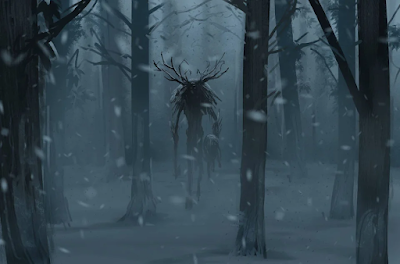
Well, it’s almost that time of year again. It’s cold and gloomy out there, but fairy lights are twinkling in windows, street vendors selling fir trees on foggy corners, and shop windows glowing with toys, tinsel and that distinctive warm and rosy light.
Yes, Christmas is just around the corner, so that’s what I’ll be talking about today. To begin with, I’m going to read you all a brief extract from SPARROWHAWK, my Christmas novella of 2010, which made it onto the final ballot of the British Fantasy Awards. But in addition to that, I’ll be reviewing THE HAUNTING SEASON, an anthology of atmospheric Christmas and winter ghost stories, published for the festive season last year by Sphere (unusually, with no individual editor credited). Apologies to all concerned that this review is in effect a year late, but I only acquired this book late last December, so there was no real opportunity to review it then in time for Christmas Eve. It’s still available anyway, so hopefully this review will not be wasted.If you’re only really here to let me entice you to THE HAUNTING SEASON , then by all means take a sleigh ride to the bottom end of today’s column where you’ll find the review, as usual, in the Thrillers, Chillers section.
On the other hand, you could bear with me a little longer, and I’ll take you to another haunting Christmas …
Long, long ago
SPARROWHAWK remains my personal favourite piece of work. I wrote it intentionally as my ode to Victorian era ghostly fiction but also to the Christmas season, my favourite time of year, and a celebration that I’ve never really been able to separate from thoughts of the supernatural.
 As a child, the magical, mystical nature of Christmas was almost tangible to me. It wasn’t just the midwinter atmosphere: the long darkness, the icicles, the snow flurries. Or that huge range of Christmas folklore and mythology: the elves in the evergreens, Loki and the mistletoe spear, St Boniface and the sacred oak, Belsnickel, Krampus etc etc. It was the fact that this was a holy feast, it was Heaven-sent, which basically gave you full permission to believe in the fantastical.
As a child, the magical, mystical nature of Christmas was almost tangible to me. It wasn’t just the midwinter atmosphere: the long darkness, the icicles, the snow flurries. Or that huge range of Christmas folklore and mythology: the elves in the evergreens, Loki and the mistletoe spear, St Boniface and the sacred oak, Belsnickel, Krampus etc etc. It was the fact that this was a holy feast, it was Heaven-sent, which basically gave you full permission to believe in the fantastical. The Son of God had genuinely been born in a stable in Bethlehem on Christmas Day over 2,000 years ago, an angel taking the glad tidings to local shepherds, wisemen from the East following a star so they could pay tribute. A miracle for sure, which surely meant that other miracles happened around this time of year too.
Father Christmas, as we called him in Britain (or Santa Claus in the States, Sinterklass in the Netherlands, Père Noël in France) was real (of course he was real!) because he was a saint, who if he didn’t actually personify in the shape of a chubby old man in a red cloak and a fur-trimmed hood, at least imbued the season with jollity and good will – something that happened at no other time of year I was aware of.
Many supposedly true ghost stories I’d heard involved manifestations specifically at Christmas.
It’s a moment when ‘the hopes and fears of all the years’ are close to us, and so the spirits – in that time-honoured fashion of A Christmas Carol – often visit as heralds, bearing warnings about the future or disapproving messages concerning the way we’ve lived our lives to that date.
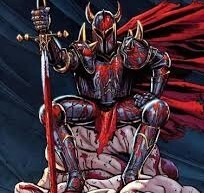 (One of the eeriest I ever heard featured Geoffrey de Mandeville, a brave knight of the 12th century, but in later life a robber baron, who was doomed after death to ride around the perimeter of his long-demolished castle every Christmas Eve in a cloak and armour soaked with the blood of his victims).
(One of the eeriest I ever heard featured Geoffrey de Mandeville, a brave knight of the 12th century, but in later life a robber baron, who was doomed after death to ride around the perimeter of his long-demolished castle every Christmas Eve in a cloak and armour soaked with the blood of his victims). In light of all that, it seemed perfectly natural to me to both read and write ghost stories at Christmas. The two clearly went hand in hand, and of course it wasn’t just me. Umpteen classical authors had already done the same thing.
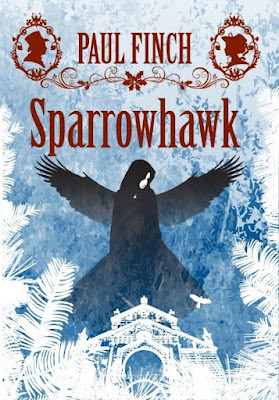 As such, those who follow this column regularly will know that, each year in December, I try to publish a free-to-read Christmas ghost story on here. The truth is that it’s often a toss-up whether I’m able to do this because time doesn’t always allow (though I’ll be trying again in the days ahead). But
SPARROWHAWK
was a particularly good effort on my part, if I say so myself, even though it did eventually run to just under 30,000 words.
As such, those who follow this column regularly will know that, each year in December, I try to publish a free-to-read Christmas ghost story on here. The truth is that it’s often a toss-up whether I’m able to do this because time doesn’t always allow (though I’ll be trying again in the days ahead). But
SPARROWHAWK
was a particularly good effort on my part, if I say so myself, even though it did eventually run to just under 30,000 words. It was first published by Pendragon Press at Christmas 2010 and later short-listed for the British Fantasy Award, only losing out to my good mate and all-round excellent writer, Simon Clark, so I can hardly complain. Despite that, I remain completely happy with this novella, genuinely feeling that it hit every target I was aiming at. But of course, I can’t really be the judge of my own work; that’s up to my readers. However, a couple of years ago, with the Pendragon version now long out of print, it was republished in paperback by my own small publishing house, Brentwood Press, and released on Kindle and Audible as well, the latter version admirably read by that wonderful actor, Greg Patmore.
I won’t say anymore because this is turning into a bit of a hard sell, which is not what I wanted to do. Instead, I’ll let the book do the talking, or a little bit of it. Here, as promised, is a short extract from SPARROWHAWK , which I recorded a couple of days ago. Perhaps give it a listen if you’ve got a few minutes spare, and see what you think, hey?
THRILLERS, CHILLERS, SHOCKERS AND KILLERS …
An ongoing series of reviews of dark fiction (crime, thriller, horror and sci-fi) – both old and new – that I have recently read and enjoyed. I’ll endeavour to keep the SPOILERS to a minimum; there will certainly be no given-away denouements or exposed twists-in-the-tail, but by the definition of the word ‘review’, I’m going to be talking about these books in more than just thumbnail detail, extolling the aspects that I particularly enjoyed … so I guess if you’d rather not know anything at all about these pieces of work in advance of reading them yourself, then these particular posts will not be your thing.
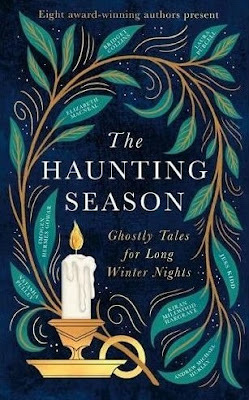 THE HAUNTING SEASON
by Various (2021)
THE HAUNTING SEASON
by Various (2021)
A beautifully presented anthology of original Christmas and winter-themed ghost stories, mostly set in the past and with a decidedly Gothic aura. Before we get into it, I’ll let Sphere, the publishers, give you their own official blurb:
Winter, with its unsettling blend of the cosy and the sinister, has long been a popular time for gathering by the bright flame of a candle, or the warm crackling of a fire, and swapping stories of ghosts and strange happenings.
Now eight bestselling, award-winning authors – master storytellers of the sinister and the macabre – bring this time-honoured tradition to vivid life in a spellbinding collection of new and original haunted tales.
Taking you from a bustling Covent Garden Christmas market to the frosty moors of Yorkshire, from a country estate with a dreadful secret to a London mansion where a beautiful girl lies frozen in death, these are stories to make your hair stand on end, send shivers down your spine and to serve as your indispensable companion to the long nights of winter.
So curl up, light a candle, and fall under the spell of The Haunting Season …
The telling of ghost stories at Christmas and in the depths of winter is one of our most time-honoured literary traditions. I’ve waxed lyrical many times on this blog about the joy to be found in spinning spooky yarns while seated around the fire with snow-laden winds whipping at the window.
The likes of Charles Dickens and MR James, of course, dined out on the tradition, while even Shakespeare mentioned it. Anyone recall the throwaway line in A Winter’s Tale ? ‘A sad tale’s best for winter. I have one. Of sprites and goblins.’
Many writers have followed in these venerable footsteps since, with the net result that Christmas, or midwinter – because not all the stories in The Haunting Season are specific Yuletide celebrations – now sits alongside Halloween as the time for eerie tales. And I am so delighted, I can’t stress that enough – I am SO delighted – that now at last, after what seems like an eternity, we see a major publisher getting in on the act.
Though no single editor is credited for The Haunting Season , it excites me no end to see that this beautifully bound and illustrated anthology comes to us from Sphere, an imprint of Little, Brown. Does this mean that we’ll see further commissioning of original short fiction by the major houses? Time (and sales) will tell. But I’m cautiously optimistic, because this outing in particular has been quite successful.
On the subject of caution, that is one of the most notable features of this particular collection, I feel. It’s a cautious, or careful, exploration of the supernatural field, rather than a full-on dive into it. There are lots of effective tales here, though very few (if any) absolute spine-chillers, and nothing that is likely to shock. Of the eight stories contained here, there is only one I’d classify as a ‘horror story’, and that one is also subtle and meaningful. But there is also much here about subtext and undertone, the majority of which comes from a feminist persuasion. Which is absolutely fine by me, and works very well in this context, and which is also understandable because of the eight contributing authors, seven are women.
I will admit to being a tad perplexed that the bulk of these tales are set in that timeless Victorian/Edwardian timeloop, where so much ghostly fiction of the classical variety dwells. That makes for a slightly less diverse collection than I was expecting, but even now in the 21st century, that era remains our go-to period for Gothic fiction, so one can’t complain too much.
There is also, maybe, an over-preponderance of upper-crustiness in The Haunting Season . There are several country house tales here, while more than a few characters derive from the ruling class. But I reiterate, this was often the way of it with the Victorian ghost story tradition, so I see no real harm.
The stories themselves, without exception, are exquisitely written, are populated by memorable personalities (Natasha Pulley, for example, utilising characters from her very successful Watchmaker of Filigree Street series), and hit us with a range of supernatural antagonists.
Inevitably, of course, in that great custom of the Victorian ghost story, there are many mysteries to be solved.
For example, in Laura Purcell’s The Chillingham Chair , a spirited young woman is unable to attend her sister’s wedding thanks to a broken foot incurred during a riding accident. However, the wheelchair she is confined in now seems to develop a life of its own and attempts to impart a warning message, possibly about the potential fate of her sister …
The one contemporary tale I referenced, The Hanging of the Greens by Andrew Michael Hurley, presents us with a story inside a story, and a protagonist who must venture into the back of beyond to get the answers he seeks, though I found this contribution to the book particularly disturbing – it’s certainly a new twist on the festive chiller – so more about this one later.
Other stories meanwhile, while not exactly mysteries, hint strongly at the troubled pasts of those individuals participating, and leave much to the reader’s own (hopefully dark) imagination.
Bridget Collins’s A Study in Black and White is a great example. In this eerie outing, an unpleasant man on the run from his misdemeanors rents a 17th century house in the countryside. Intent on staying there alone, he soon becomes aware of an unseen presence, a presence that enjoys a game of chess, though it appears even more to enjoy winning.
Likewise in Thwaite’s Tenant by Imogen Hermes Gowar, the central character is displaced from one threatening location to another, which turns out to be even worse, though the exact details of what happened there are initially elusive. I enjoyed this one thoroughly, so a little more on this later.
Perhaps the most mysterious of all the stories in The Haunting Season is Monster by Elizabeth Macneal. It features a selfish protagonist on the trail of an elusive prize and entering a realm so soaked in mythology that it’s almost unreal. More on this one later, too.
For straightforward terror, meanwhile, though with a deep subtext, we go to Kiran Millwood Hargrave’s Confinement , wherein a woman suffering in the grip of a terrifying supernatural foe, may actually be at the mercy of her own tortured psyche. A poignant tale, this one, as well as a scare-fest, it has meaning far beyond the pages and remit of this anthology, so more about this one later as well.
Equally strange and delightful reads are provided by Natasha Pulley with The Eel Singers , in which a close group of friends take a trip out of London to the wintry fen country, only to encounter some locals who are not quite the welcoming crowd they anticipated, and Jess Kidd with Lily Wilt , in which a professional photographer of the dead falls in love with his latest project, a beautiful and delicate young woman recently deceased, and uses black magic to restore her to life, only to find that she is a long way from the woman she once was (or is she?).
All round, The Haunting Season does exactly what it says on the cover, delivering a bunch of original short fiction, all expertly and sumptuously written (there isn’t one dud in that regard), all flavoursome of the deep winter, and all offering hints of that gentle horror, or should we perhaps say ‘pleasing terror’ that so earmarks the traditional ghost story for Christmas. If that’s what you’re looking for, you’ll find it here.
And now …
THE HAUNTING SEASON – the movie
Okay, no film maker has optioned this book yet (as far as I’m aware), and I honestly don’t know how likely it is, but as this part of the review is always the fun part, here are my thoughts just in case someone with cash decides that it simply has to be on the big screen in time for next December.
Note: these four stories are NOT the ones I necessarily consider to be the best in the book, but these are the four I perceive as most filmic and most right for adaptation in a compendium of ghost stories. Of course, no such film or TV series can happen without a central thread, and this is where you guys, the audience, come in. Just accept that four strangers have been thrown together in unusual but festive circumstances, which require them to relate spooky tales. It could be that they’re marooned at a snowbound coaching inn and keeping each other company around the Christmas Eve fire, or perhaps are regaling Mr Dickens with recollections of their own experiences after he amuses his guests at a Yuletide dinner party with the first chapter of A Christmas Carol.
Without further messing about, here are the stories and the casts I would choose:
Thwaite’s Tenant (by Imogen Hermes Gowar): A woman, fleeing with her child from a brutal husband, seeks refuge in a desolate house used by her father for his assignations with various mistresses. But she finds it a dark abode where the many memories of male cruelty refuse to lie at rest …
Lucinda – Charlene McKenna
Father – Jim Carter
Mrs Farrar – Rita Tushingham
Monster (Elizabeth Macneal): A younger son, insanely jealous of his horticulturist brother and unmanned by his beautiful wife, seeks greatness by searching for dinosaur bones on the Jurassic Coast. When he uncovers a fully intact plesiosaur skeleton, it’s a wondrous moment, but it comes at a ghastly psycho-supernatural price …
Victor – Darren Boyd
Mabel – Kelly MacDonald
The Hanging of the Greens (by Andrew Michael Hurley): A former vicar recalls the event that cost him his faith: a trip to a lonely farm in the snowswept Bowland hills, to offer an apology from a troubled parishioner to the couple he believes he offended. But a terrifying truth awaits him there …
Edward Clarke – Dominic West
Joe Gull – Jack O’Connell
Confinement (by Kiran Millwood Hargrave): A woman returns to England from India pregnant. But the difficult labour and birth is made worse by the story she has heard that her nearest neighbour was an evil woman hanged for baby-farming. Is the nightmarish figure that now haunts the new mother a figment of post-natal depression, or something even more terrible? …
…
Catherine – Sophie Turner
Published on December 06, 2022 06:06
December 1, 2022
Never Seen Again hangs in place of honour

As you can see, Helen Roberts’ remarkable and beautiful interpretation of my recent crime novel, NEVER SEEN AGAIN, is now framed and hanging on the wall in our living room, in a place of honour.
When we originally set out on this road, I had no idea what the final outcome would be. But here it is … and even though much has happened, I still feel hugely honoured that anyone, let alone someone as talented as Helen, would take it on themselves to create an original painting based on any book of mine. I appreciate that my snapshot doesn’t really do the painting justice, but as Helen has recently sent through some notes outlining the main influences she took from the novel, I thought I’d get up close and a bit more personal with the picture, and relay these to you myself on video.
You’ll find that below, along with some short story news. In addition to that, because we’re again on the subject of mystery-thrillers but with an undercurrent of the arts, I’ll be reviewing THE DOLL-MASTER, another exquisite collection of shorts by that mistress of literary dark fiction, Joyce Carol Oates.
If you’re only here for the Oates review, shoot down to the lower end of today’s blogpost, where you’ll find it, as usual, in the Thrillers, Chillers section. If on the other hand, you haven’t yet had enough for my novel-to-painting chatter, stick around for …
All on canvas
I don’t want to repeat too much of my previous blogpost today, so I’ll keep this introduction short and sweet. You’ll hopefully recall that, last summer, a challenge was put to the Birmingham Art Zone to transform my crime novel of 2022, NEVER SEEN AGAIN , into a single canvas.
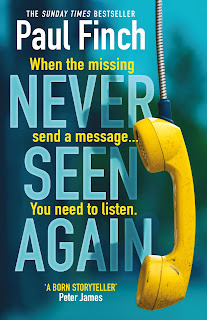 In my mind, this would be an artistic interpretation of the whole novel, rather than an alternative book-cover or an advertising poster, though in speaking to the artists interested in participating, I made no requirements at all. It was to be entirely up to them what they did (a little bit like the notes I send out to those writers who compete to appear in my
TERROR TALES
anthologies: “DO what you DO”).
In my mind, this would be an artistic interpretation of the whole novel, rather than an alternative book-cover or an advertising poster, though in speaking to the artists interested in participating, I made no requirements at all. It was to be entirely up to them what they did (a little bit like the notes I send out to those writers who compete to appear in my
TERROR TALES
anthologies: “DO what you DO”). You may ask why Birmingham was chosen instead of my native Northwest. Well, that’s because Birmingham’s Westside Business Improvement District, with whom I’ve become very friendly in recent years, were hugely supportive of the idea and threw it out to their local artists.
The three painters who eventually undertook the challenge – Helen Roberts, the eventual winner, and runners-up, Helen Owen and Paula Gabb – did, frankly, an incredible job. Any one of their finished works could have taken first place.
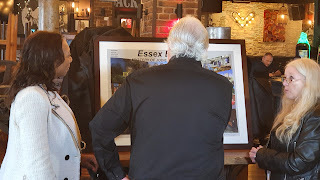 It was extraordinarily difficult to choose between them, especially as it was live on news camera in the Velvet Music Rooms and the ladies were all standing there in front of me, when the decision was made.
It was extraordinarily difficult to choose between them, especially as it was live on news camera in the Velvet Music Rooms and the ladies were all standing there in front of me, when the decision was made. Having pondered the winner for a couple of weeks now, all I can really say about why I chose this one over the others is because of the way the central figure in it, Jodie Martindale, immediately hooked me with those hauntingly beautiful eyes, and said: “Come and find me, please. I was kidnapped six years ago. No, we don’t know who by. Yes, I’ve never been seen or heard from since. But I’m still alive. So please, send someone to find me.”
But enough. Rather than keep waffling on via keyboard, here’s a video I shot once we’d got the painting framed, in which I present some of the info that was transferred over to me by Helen Roberts herself. A quick word of warning: if any of you haven’t read the novel yet, and are still hoping to, there may be one or two SPOILERS here, so it might be an idea to only watch this video when you’ve turned the final page.
So, there we go. Apologies for my slightly rough and ready approach and shoddy camerawork. I’m no expert at this sort of thing, but hopefully you’ll find it interesting. (One detail I’ve stupidly neglected to mention, is the pendant that Jodie is touching so delicately at her throat. That is the symbol of the United Nations Blue Heart campaign, which raises awareness around the globe about human trafficking. A beautiful touch of Helen’s own).
Short story updates
I have one or two other things to report as well, which I’m quite excited about.
Proof that my TERROR TALES anthology series is as strong as it ever was, if not stronger, has finally arrived in the form of a number of the stories included in last year’s TERROR TALES OF THE SCOTTISH LOWLANDS gaining the attention of Ellen Datlow, that inestimable editor of the Best Horror of the Year series along with countless other high-end horror anthos.
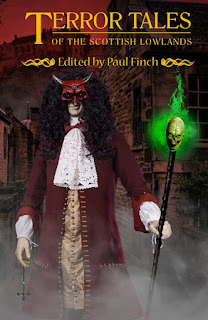 To start with, Steve Duffy’s
The Strathantine Imps
, which for me absolutely nails the folk horror vibe I look for in this series but in an all-new and subtly terrifying way, has been chosen for full reprint in
BEST HORROR OF THE YEAR 14
(as I knew it would – just ask the author, and he’ll confirm that I told him this on first reading it).
To start with, Steve Duffy’s
The Strathantine Imps
, which for me absolutely nails the folk horror vibe I look for in this series but in an all-new and subtly terrifying way, has been chosen for full reprint in
BEST HORROR OF THE YEAR 14
(as I knew it would – just ask the author, and he’ll confirm that I told him this on first reading it). But the laurels don’t end there. Five other stories featuring in LOWLANDS have been singled out for special mention in Ellen’s annual longlist of the year’s best horror, which also appears in BEST HORROR OF THE YEAR 14 .
They are: The Moss-Trooper by MW Craven, Drumglass Chapel by Reggie Oliver, Herders by Willie Meikle, Birds of Prey by SJI Holliday and The Fourth Presence by SA Rennie.
Now, all told, that’s a substantial chunk of TERROR TALES OF THE SCOTTISH LOWLANDS , I hope you’ll agree. And as editor of the series, I’m really delighted that we’re winning such acclaim. If you’d like to know what the TERROR TALES books are all about, you can always check them out for yourself … HERE .
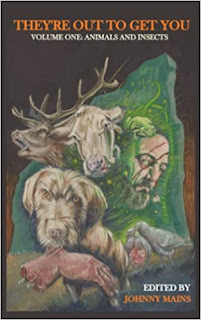 On a personal but not entirely dissimilar note, I’d like to mention, if you’ll permit me, that a story of mine from 2021,
Uncaged
, as first published in
THEY’RE OUT TO GET YOU
, edited by Johnny Mains, has also made the longlist in
BEST HORROR OF THE YEAR 14.
I must admit to being very happy with this. I don’t get time to write many short stories these days, so when I do put them out there, it’s gratifying to see them recognised.
On a personal but not entirely dissimilar note, I’d like to mention, if you’ll permit me, that a story of mine from 2021,
Uncaged
, as first published in
THEY’RE OUT TO GET YOU
, edited by Johnny Mains, has also made the longlist in
BEST HORROR OF THE YEAR 14.
I must admit to being very happy with this. I don’t get time to write many short stories these days, so when I do put them out there, it’s gratifying to see them recognised. Uncaged is a slightly unusual one for me in that it’s set in the distant past (a hint of future novels to come, perhaps?), at the height of the Roman Empire in fact, but its contents concern events that I trust will be familiar enough to put a thrill of fear even into the most modern bloodstream.
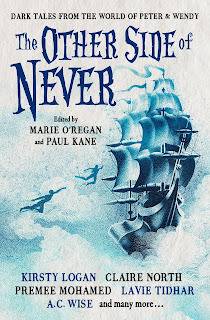 Hopefully, without beating my own drum too much, Can I also draw
Hopefully, without beating my own drum too much, Can I also drawyour attention to another short story of mine, No Such Place , which will appear next year in a the fantasy/horror anthology called THE OTHER SIDE OF NEVER . I think you can see for yourself that this one will contain dark stories inspired by the many legends surrounding Peter Pan. The editors in this case are the ever-energetic Paul Kane and Marie O’Regan.
THRILLERS, CHILLERS, SHOCKERS AND KILLERS …
An ongoing series of reviews of dark fiction (crime, thriller, horror and sci-fi) – both old and new – that I have recently read and enjoyed. I’ll endeavour to keep the SPOILERS to a minimum; there will certainly be no given-away denouements or exposed twists-in-the-tail, but by the definition of the word ‘review’, I’m going to be talking about these books in more than just thumbnail detail, extolling the aspects that I particularly enjoyed … so I guess if you’d rather not know anything at all about these pieces of work in advance of reading them yourself, then these particular posts will not be your thing.
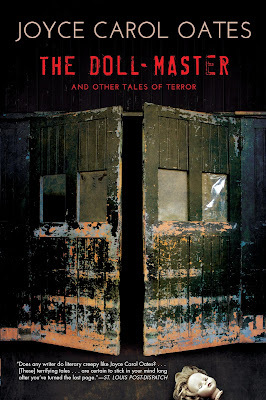 THE DOLL-MASTER
by Joyce Carol Oates (2016)
THE DOLL-MASTER
by Joyce Carol Oates (2016)
Joyce Carol Oates is one of the most revered authors working in America today, and the creator of a phenomenal body of work, which includes 58 novels, plus numerous plays, novellas and collections of short stories and poems. She’s also been the recipient of countless awards and honours and has five times been shortlisted for the Pullitzer Prize. Fortunately for those of us who prefer our fiction dark, Oates, while a keen advocate for social justice, often focusses on the grimmer aspects of life in her writing, and as such is a regular creator of high-quality horror and thriller literature
Fans of the short form are particularly well-served by Oates, whose eerie and mysterious tales have appeared regularly in magazines and anthologies, and as already stated, are often published in special single-author collections, all of which are worth checking out. The Doll-Master , which appeared in 2016, is only one such. Here is the blurb that graced its back cover:
Six terrifying tales to chill the blood from the unique imagination of Joyce Carol Oates.
A young boy plays with dolls instead of action figures. But as he grows older, his passion takes on a darker edge...
A white man shoots dead a black youth creating a media frenzy. But could it have been self-defense as he claims?
A nervous woman tries to escape her husband. He says he loves her, but she's convinced he wants to kill her...
These quietly lethal stories reveal the horrors that dwell within us all.
One of the most interesting aspects of Joyce Carole Oates’ writing in the darker genres – and we shouldn’t be surprised by this, because her remit goes much further afield than that – is her ability to spin scary stories that are a world away from the more conventional realms of ghosts, monsters, goblins and psychopaths. I mean, don’t get me wrong, she’s more than capable of straying into all these territories, especially the latter. But Joyce Carole Oates’ fiction is invariably set in the mundane realities of everyday folk.
Terrible things invariably happen, but usually in circumstances the majority of us would recognise: broken homes, dysfunctional families, impoverished neighbourhoods, the aberrant minds of people who are basically unable to cope. She doesn’t judge. You almost never get anyone who is evil for evil’s sake. Likewise, though there is gore and violence, it rarely goes over the top. And contrivance is never on show. There is certainly nothing in The Doll-Master that would make you think the situation couldn’t genuinely occur. This makes every one of her short stories so much more of a gut-punch than it would be otherwise. It also may explain there is something of a pattern in this particular collection, quite a few of the stories ending ambiguously, leaving distinct uncertainty in the mind of the reader, and strongly hinting that in real life, serious problems are never just packaged away and done with. There will always be an aftermath, there will regularly be a second twist in the story that you never saw coming.
As The Doll-Master contains only six stories (all quite lengthy, novelettes really), I won’t do what I usually do with collections of stories, which is select the ones I liked the best and talk about them in extra detail. Instead, I’ll run through them all in chronological order. And as I always enjoy doing some fantasy casting at the end, I’ll do the same here, only will invent a TV series adaptation and pick out a few actors for each episode (all in the spirit of having a laugh of course).
The Doll-Master
Young Robbie falls in love with his female cousin’s new Barbie doll and steals it from her bedroom after she suffers an untimely death. But when his irritated father takes it away, he grows up in desperate need of replacements, and thus embarks on a mission to secretly collect abandoned dolls. At the same time, very disturbingly, local children start disappearing …
The unreliably narrated tale of an out-and-out psychopath, both his formation and the execution of his crimewave, as seen through his own eyes from earliest youth to young adulthood. Oates is renowned for her grim slices of ‘real-life’ horror, but even though, as with most other stories in this book, the ending to this whistle-wetter is left open (to an extent), it’s probably one of the closest in the book to the traditional macabre tale. Not because it’s filled with slasher-type nastiness, but because fear and dread are the thing, and Oates drip-feeds them in with a true master’s touch. A conte cruel from the top drawer.
In our imaginary TV show:
Robbie – Harry Gilby
Mother – Lena Hall
Soldier
Brandon Schrank, a young white misanthrope, is charged with murder when he shoots a black youth in what he claims is self-defence. The country is soon divided over the matter and a heated, even violent debate follows, neither Schrank’s supporters nor his detractors particularly concerned about whether he is innocent or guilty, instead concentrating on trying to best each other. The mystery persists, though. What happened that night when Schrank says he was attacked? …
Probably the most thought-provoking story in the book, an assessment of America’s current race issues and bizarre gun culture, and the massive passions generated on both sides of the debate, all seen through the prism of a fictional but melodramatic news story in which the actual facts are difficult to ascertain. Neither a thriller nor a horror story, but bone-chilling and prophetic in the extreme when you consider that it was written several years before 17-year-old Kyle Rittenhouse became famous for shooting three people during a public order situation in Wisconsin.
In our imaginary TV show:
Brandon Schrank – Tom Holland
Gun Accident: An Investigation
Hanna, a schoolgirl from a humble home, is delighted when her favourite teacher, the beautiful, stylish and sophisticated Mrs McClelland, requests that she access her palatial home several times while the McClellands are out of town to look after the plants and the cat. Neither Hanna nor her teacher are aware of the tragedy that will unfold when Hanna’s drug-crazed cousin, Travis, learns about this convenient arrangement …
A dark and disturbing little vignette, which is certainly a crime story, but not something you’d classify as a mystery or a thriller. If anything, it’s more a slice of social drama, a grim tale that you could really picture happening in towns where there are haves and have-nots, and where those at the very bottom of the scale have slipped into anarchic oblivion (a situation that rarely resolves itself with one-off tragedies). Yet another powerful read.
In our imaginary TV show:
Hanna – Parker McKenna Posey
Travis – Chosen Jacobs
Mrs McClelland – Julia Stiles
Equatorial
Audrey, a neurotic heiress, accompanies her ambitious academic husband on a holiday to Ecuador, but in due course becomes convinced that he has not just brought a secret mistress along with him, who is somewhere in the party they are travelling with, but also that his plan is to commit murder while they are here and so clear the way for a new relationship …
The longest story in the book and for me the least effective, though that’s primarily because, though this is yet another tale in which the author purposely cuts the narrative short, allowing us to insert the denouement ourselves, in this instance we seem to take an awfully long time getting there, and when we did, I couldn’t help feeling short-changed. This is all the more disappointing because the tension and suspense that Oates generates in the body of this narrative is immense. Equatorial has all the basics of a dark and intense psychological thriller, but in this case the lack of pay-off is detrimental.
In our imaginary TV show:
Audrey – Natascha McElhone
Henry – Patrick Dempsey
Big Momma
Violet’s over-stressed single mom moves them both to a new town and in Violet’s case, to a new school. Dumpy and unattractive, Violet feels lonely and self-conscious among all these new kids, but gradually befriends an eccentric local family, who make her welcome in their ramshackle home and keep promising that one day they will introduce her to a mysterious personality known only as Big Momma …
Probably the most ‘horror’ of all the horror stories in this collection, and easily one of the best in terms of its gleefully fiendish premise. We’re in vintage Joyce Carole Oates territory with this chiller, focussing on one of society’s misfits whose efforts to find acceptance backfire on her in the most gruesome and ghoulish way, though in this case she falls prey to her fellow misfits (proving that there is almost nobody nice in the world of Ms. Oates). This is one the old Pan Books of Horror Stories would have been happy to publish. Marvellously horrible.
In our imaginary TV show:
Violet – Milly Bobby Brown
Mr Clovis – Holt McCallaney
Mystery Inc.
A serial poisoner working under the fake name Charles Brockden is intent on acquiring a beautiful, old-fashioned bookshop in an idyllic seaside town, and so launches a careful scheme to dispose of its current owner, the elegant and friendly Aaron Neuhaus. He’s done it before and anticipates no problems, but this time finds himself in a new and frightening predicament …
We end on another high note, with just the sort of low-key suspenser that Oates excels in, something that wouldn’t be out of place in Alfred Hitchcock Presents or perhaps Thriller , as once fronted by Boris Karloff. It doesn’t really matter that in this one you can see the end coming. What works best here is the cat and mouse game played between two like-minded protagonists, the stakes at the end of which could not be higher. Thoroughly enjoyable and a fine way to found off what is overall an exceptionally good if quickfire selection of distressing stories.
In our imaginary TV show:
‘Charles Brockden’ – James Frain
Aaron Neuhaus – Ian McKellen
So, that’s The Doll-Master . I’ve been a Joyce Carole Oates fan for many a year now, usually having read her short stories in anthologies and magazines. This was the first of her actual collections that I made an effort to get hold of, and it certainly won’t be the last. So, keep tuning into this blog, and you’ll find much more from America’s grand mistress of dark letters.
And you could do a lot worse than start with this one.
Published on December 01, 2022 03:16
November 17, 2022
A first - and a fantastic 'fusion of the arts'

All I can really talk about today is what happened to me yesterday. Because it was, without doubt, the best day of my working life. It was a day in which three very talented artists each presented to me their own interpretation of my latest novel.
Yes, that’s correct. Three remarkable ladies had each taken the trouble to condense my 130,000-word thriller, NEVER SEEN AGAIN, into a single canvas. The only role I had yesterday was to attend this presentation in Birmingham and choose the winner, but believe you me, that was no small thing.
So, today’s blog will tell the story of how all of this came to pass.
In addition today, on the subject of solid mystery-thrillers (sorry, blatant bit of self-glorification there), I’ll be reviewing Ruth Ware’s compelling novel, THE WOMAN IN CABIN 10 . Anyone who’s only here for that and isn’t particularly bothered about the book-to-painting story, scoot straight down to the lower end of today’s column, the Thrillers/Chillers section, where you’ll find that review.
In the meantime though, why don’t we discuss …
 A fusion of the arts
A fusion of the arts
That’s the way this incredible new idea was first pitched to me by Mike Olley (left), boss of Birmingham’s Westside BID, and his wife, Lorraine Olley (below), a popular singer, businesswoman and media personality down in the West Midlands, while we were all sitting in The Brasshouse pub in Birmingham last summer, talking generally about our careers and interests.
 I’d just happened to mention that I was an amateur art collector, and was toying with the idea of commissioning an artist to produce a painting about the life and (often dirty) work of my main cop character, DS Mark ‘Heck’ Heckenburg, for when I recommence the Heck series next year.
I’d just happened to mention that I was an amateur art collector, and was toying with the idea of commissioning an artist to produce a painting about the life and (often dirty) work of my main cop character, DS Mark ‘Heck’ Heckenburg, for when I recommence the Heck series next year. What I’d been looking for, I said, was an actual painting. Not just a new book cover that would work for retailers, and not an advertising poster. But an original piece of art, condensing many aspects of Heck’s life and investigations into a single image that we could then use as part of the promotional campaign in 2023, but which would mainly be for hanging on the wall in our lounge.
Mike and Lorraine seemed fascinated by this concept. ‘A fusion of two art-forms,’ they called it. ‘That would be something different and new.’
On reflection, I had to agree. The creation of book covers is an art in itself of course, while high quality illustrations have been used inside books throughout the entire history of publishing. But this would be slightly different. This challenge would require an artist who was not an illustrator or a book jacket designer to interpret an entire novel in one image.
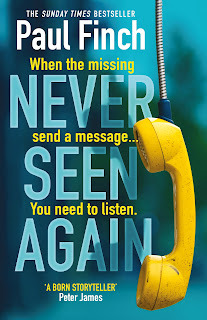 The more we discussed it, the more it became evident to me that Mike and Lorraine were seriously interested in the subject. In the end, Mike suggested that, while my plan to commission an artistic portrayal of Heck was something I already had in hand, he would be interested in doing something similar with my more recent non-Heck thriller,
NEVER SEEN AGAIN
.
The more we discussed it, the more it became evident to me that Mike and Lorraine were seriously interested in the subject. In the end, Mike suggested that, while my plan to commission an artistic portrayal of Heck was something I already had in hand, he would be interested in doing something similar with my more recent non-Heck thriller,
NEVER SEEN AGAIN
. Birmingham Art Zone
Mike put the concept to the Birmingham Art Zone, a group of highly talented artists dedicated to bringing artistic endeavour to the whole community of the West Midlands. Only then – certainly in my case – did it become apparent just what an enormous challenge this was going to be.
NEVER SEEN AGAIN is a 400 pages long thriller, concerning a violent kidnapping that has now become a cold case, a burned-out reporter trying to revive his career, corruption in the City of London, organised crime, a serial murderer called the Medway Slasher, a whole nest of dirty cops and the disgraceful scandal of international sex-trafficking.
How do you ask an artist to depict all of that in a single frame?
Well, that wasn’t for me to say. I only wrote the book. The three intrepid artists who undertook the challenge – Paula Gabb, Helen Owen and Helen Roberts – would need to decide for themselves what went into their pictures and what was left out. And thus they embarked on ‘this massive task’ as one of them described it to me, beavering away in their respective studios, with only a couple of months realistically available in which to create.
A difficult choice
Roll forward to this week, and we come to the grand unveiling – Judgement Day, as Lorraine cheerily called it – held on November 16, down at the Velvet Music Rooms on Broad Street, the artery at the beating heart of Birmingham’s cultural life.
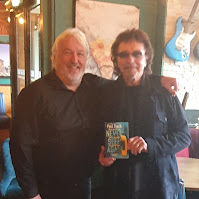 The press were in attendance, which was lovely to see, alongside some very special guests indeed, not least Tony Iommi, legendary lead guitarist of rock/metal pioneers Black Sabbath. That made it even more unbelievable for me, having been a heavy rock fan since I was at junior school, so the moment when Tony asked me to sign a copy of
NEVER SEEN AGAIN
for him (see right) was almost more than I could handle.
The press were in attendance, which was lovely to see, alongside some very special guests indeed, not least Tony Iommi, legendary lead guitarist of rock/metal pioneers Black Sabbath. That made it even more unbelievable for me, having been a heavy rock fan since I was at junior school, so the moment when Tony asked me to sign a copy of
NEVER SEEN AGAIN
for him (see right) was almost more than I could handle.When the paintings were revealed one by one, each one then presented to me by the artist responsible, I was actually very unnerved. I’ve had no formal training as an art critic, I just know what I like. But on this occasion, quite frankly, I liked all of them.
At no stage had I prescribed what I wanted the artists to paint (who would I be, to tell an artist how to do their job?). But secretly I’d hoped, as I’ve already hinted, that I wouldn’t just get an alternative piece of jacket art or what you might describe as a screen-grab, i.e. a single moment from the novel represented in oils. I was looking for an interpretation of the whole thing, if that was possible.
And as it turned out, it was … because that is exactly what I got in all three cases.
If I tell you now that none of the three were losers and that I loved them all equally, and only in the end chose one because that was the purpose of the exercise, you might consider it a cliché tossed out casually to prevent anyone feeling bad. But actually it would be 99.9% true.
 I couldn’t believe the standard of the three images I was confronted with.
I couldn’t believe the standard of the three images I was confronted with. All three artists had taken a deep, deep dive into the novel, producing wondrous and tumultuous depictions, any of which, even taken out of context, would immediately have spoken to me about my book.
Of course, none of this made it any easier, choosing, but though Helen, Helen and Paula were all standing watching at the time, to their everlasting credit they remained bright-eyed and happy all the way through. They’d all bought fully into the concept and were delightful with me both before and after the final decision was made.
Photo-finish
The two runners-up, in no specific order, were Paula Gabb’s and Helen Owen’s paintings.

Paula’s piece, as seen above, took a ‘journalistic’ angle on the book, recreating all the salient moments in the narrative visually, throwing them together as though they were photographs on a storyboard, connecting them with concise but crucial notations.
Her attention to detail was astonishing: nothing relevant from any of those key moments was absent from her painting. It told near enough the whole story, very succinctly.
 Helen Owen’s piece, meanwhile, on the right, offered what I considered to be a very (perhaps the most) ‘artistic’ interpretation.
Helen Owen’s piece, meanwhile, on the right, offered what I considered to be a very (perhaps the most) ‘artistic’ interpretation. Not entirely abstract but strongly leaning that way.
Very effectively stylised, areas of light and colour interspersing with darker, more menacing imagery to indicate the many highs and lows the characters in the novel undergo, semi-subliminal gravestones in the background hinting at the fate of so many.
And through the middle of it all, a road leading not so much to redemption as to uncertainty, which I felt nicely underlined the conclusion to the novel, wherein the evil, while it is certainly evaded, is not necessarily defeated, which in its turn then poses the questions: when will it reappear, and what form will it take next time ... and will we be ready for it?
The winner
The winner – and I’m not kidding when I repeat that this was a photo-finish – was Helen Roberts’ version of NEVER SEEN AGAIN .

The first thing that struck me about this particular piece of work was the face of Jodie Martindale in its very centre, staring out at me with the most hauntingly beautiful pair of eyes. Those who’ve read the novel will recollect that Jodie was kidnapped six years before the narrative really commences, and though her boyfriend, who was also taken, was found zip-tied and shot through the back of the neck only a couple of days later, Jodie herself has never been heard from since.
Jodie is thus the central character in NEVER SEEN AGAIN even though she barely appears in it. She is the person whom our flawed heroes finally unite in order to try and find, putting everything on the line, including their lives. Her beauty and intellect, and her reputation as a good person, pervade the entire story, intensifying the tragedy of her unsolved abduction – and to suddenly see her looking out at me like that, literally locking gazes with me, was a near mesmerising moment.
The rest of the painting is also filled with meaningful symbols, so many that I suspect I’d need to dedicate a different blogpost to assessing them all, along with many other key moments and personalities from the book. Anyway, here I am below, presenting the winning artist, Helen Roberts, with her prize.

I don’t want to talk too much more now about this event for fear of getting self-indulgent, but I will add that a video telling the whole story of the ‘paint-off’ competition, which was filmed up here in my home town, Wigan, as well as down in Birmingham, is now in production and will be launched at a Birmingham venue in the New Year.
Because I obviously haven’t posted enough pictures of this major event in my life, here are one or two more. In addition, if you feel I haven’t written enough about it either, you can read a lot more HERE .




THRILLERS, CHILLERS, SHOCKERS AND KILLERS …
An ongoing series of reviews of dark fiction (crime, thriller, horror and sci-fi) – both old and new – that I have recently read and enjoyed. I’ll endeavour to keep the SPOILERS to a minimum; there will certainly be no given-away denouements or exposed twists-in-the-tail, but by the definition of the word ‘review’, I’m going to be talking about these books in more than just thumbnail detail, extolling the aspects that I particularly enjoyed (I’ll outline the plot first, and follow it with my opinions) … so I guess if you’d rather not know anything at all about these pieces of work in advance of reading them yourself, then these particular posts will not be your thing.
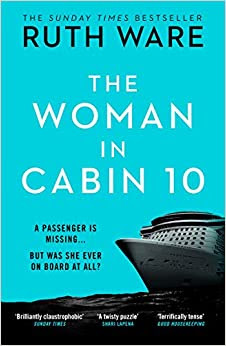 THE WOMAN IN CABIN 10
by Ruth Ware (2016)
THE WOMAN IN CABIN 10
by Ruth Ware (2016)
Outline
Laura ‘Lo’ Blacklock is an ambitious and talented travel journalist, who on the surface has it all. A glamorous job with uber-cool mag, Velocity, great talent, a hunky American boyfriend, Judah, who also happens to be a successful reporter (and who absolutely adores her), and now an opportunity to travel on the Aurora, one of the world’s most luxurious holiday yachts, which will shortly be making its maiden voyage to the Norwegian fjords to check out the Northern Lights.
But Lo, who has a more fragile personality than many might realise, was recently terrorised in her London flat when a masked burglar broke in and helped himself to her valuables while she was present. Though she was physically unhurt, the result is nightmares, insomnia, a series of terrifying flashbacks and an increasing reliance on alcohol and prescription pills to get her through each day. This stew of self-medication ends up clouding her judgement badly, which leads to a fall-out with Judah, who has turned down a massive job offer in New York in order to stay with her, a huge sacrifice that she is almost indifferent to.
When she finally arrives on the Aurora, which is owned by British business mogul, the effortlessly smooth Lord Richard Bullmer, she experiences a degree of lavishness she never knew existed, and finds herself in the company of a range of wealthy and eccentric socialites, none of whom, in Lo’s distressed and crotchety state, seem entirely ‘right’.
Among others, there is Cole Lederer, a handsome, vaguely predatory photographer; Alexander Belhome, a pompous, corpulent hedonist; Chloe Jenssen, a beautiful model, and her wealthy investor husband, Lars; and Archer Fenlon, a rugged, Yorkshire-born outdoorsman, who seems very out of place here. Lord Bullmer himself is the dominant character, though his life isn’t entirely perfect, as his wife, Anne, is also present, a sad, frail woman who is vastly wealthy in her own right but currently in the middle of a losing battle with cancer (not that Bullmer seems to be especially affected by this).
If nothing else, Lo is glad to see a couple of fellow journalists, though Tina West is a waspish rival whom she doesn’t trust, while Ben Howard, though a former lover of Lo’s, is a confident swaggerer even in this society, which galls her, and, because he once shared Lo’s bed, is now inclined to take liberties with her, which she also doesn’t like.
For all that she feels out of her depth, Lo is determined that her trip on the Aurora, and the write-up she will give it, will be her big break in travel-writing. But on the first night of the cruise, things take a turn for the totally surreal.
Lo, still emotionally exhausted and already on her way to being drunk, is preparing for her first real evening in the company of the rich and famous, and so pops next door, to Cabin 10, to borrow some mascara. A young woman she hasn’t seen before, who appears very flustered to have suddenly come face-to-face with one of her fellow travellers, provides the missing cosmetic and then slams the cabin door in Lo’s face.
Lo gets through the evening by continually dosing herself with alcohol, though she notices that the young woman from Cabin 10 doesn’t appear. Later, back in her own cabin, very drunk, Lo is just dozing off when she is disturbed by the sound of a scream next door, and then a loud splash, as if something hefty has been tossed overboard. Staggering out onto her veranda, Lo is appalled to see what looks like a body submerging between the dark, foam-covered waves. She also spots what looks like a smear of blood on the glass partition separating her from the veranda attached to Cabin 10.
Convinced the young woman she saw there has been murdered, and equating it with her own experience during the London burglary, Lo makes a big fuss, but when the yacht’s security chief, Johann Nilsson, takes charge, she is startled to learn that Cabin 10 is unoccupied. It was booked, but the expected guest was unable to attend, and no one has been in there since. They check the cabin out together, and it is stripped and bare. In addition, there is no trace of any blood.
The next day, Lo and Nilsson make a tour of the vessel, but nowhere does she see anyone who resembles the woman from Cabin 10. Instead, she is introduced one by one to the helpful and improbably good-looking Scandinavian crew, though none of them are able to assist her. Everyone who is supposed to be on board is present and correct; no one is missing.
If nothing else, Lo still possesses the mascara she borrowed from the woman, which, to her mind at least, is proof of what she thinks happened. But Nilsson is not impressed, arguing that the mascara could have belonged to anyone. When, later on, the mascara goes missing too, Lo demands an explanation, and Nilsson finally gets frustrated with her, pointing out that her combined diet of drugs and alcohol is hardly making her a reliable witness, and that her constant questioning of people is becoming a nuisance.
Still convinced that she met someone in Cabin 10, but also aware that she has skewed her own sense of reality in recent times (now suspecting that everyone on board is watching her and whispering), Lo wonders if there might be something in Nilsson’s assertion that she has basically made a huge and embarrassing faux pas. Helpless to do anything else, she tries to relax in the yacht’s spa, hoping to get it together, only to fall asleep and then wake up and see a message written on the steamy mirror: STOP DIGGING …
Review
The Woman in Cabin 10 first appeared in the wake of The Girl on the Train , and obvious analogies were drawn, the main heroine’s struggles with alcoholism fuddling her attempts to work out whether she is genuinely a witness to criminal activity or simply imagining it and bamboozling her efforts to call on the assistance of others.
The really big difference with The Woman in Cabin 10 , though, is that Ruth Ware takes her story out of the suburbs, where so much modern day psychological noir is located, and plonks it down in one of the most isolated spots you can imagine: a small cruise-liner, far out in the North Sea, where, once the internet has gone down, contact with the outside world is all but impossible.
This is a very neat idea, but Ware intensifies the tale all the more by moving it away from the normal ‘blue sea / blue sky’ cruise ship experience, plunging us into the far north, a realm of cloud, bitter rain and dark, cold seas. On the few occasions Blacklock is able to go ashore, she’s on the rugged Norwegian coast, where spume explodes from the rocks, and any footpath or road invariably leads steeply uphill in its attempts to navigate the dizzying slopes of the fjords.
So, once Lo Blacklock reaches a solid conclusion that she’s onto something – not just that she witnessed a murder but that she herself is now in peril – the sense of discomfort becomes overwhelming. Especially as she still has no way to identify the killer (or killers). Ruth Ware, like all good thriller writers, now works this scenario for everything she can. In scenes as tense as a hangman’s rope, Lo moves among her fellow passengers and the yacht’s highly efficient staff, watching every one of them carefully, and seeing (or imagining) all kinds of oddities and idiosyncrasies that might lead her to suspect them.
The tension mounts as the vessel encroaches on its first scheduled stop, Trondheim, where the journalist knows she’ll be able to get ashore and speak to the police, meaning that, if she’s going to become a victim herself, it will need to happen before then.
The extra layer of oppression that Ware adds through the device of Lo’s booze-fuelled anxieties only worsens her predicament, mainly because it means that other characters don’t believe her. On the other hand, we the readers know that she’s onto something. For all Lo’s acute paranoia and pernicious self-doubt, we shared the incident involving Cabin 10 with her. Despite her wibbly-wobbly recollections, we saw it happen for ourselves.
In that regard, the ‘unreliable narration’ technique didn’t entirely work for me.
On a not dissimilar subject, if there’s a weakness in The Woman in Cabin 10 , I think it’s rooted in the character of Lo Blacklock herself. She is both physically and mentally enfeebled by her bad experiences. Which is fair enough. But it’s turned her into someone rather unpleasant. While you might agree with her assessment that the Aurora is all about rich people enjoying a holiday at the expense of poor people, you can’t help cringing at her whiny snappiness. Yes, she’s had a hard time, but she’s supposed to be a professional journalist, someone whose grand plan is to travel the world, reporting on all kinds of troublesome situations, so you can’t help feeling that she could make a bit more of an effort to get back in the saddle.
Aside from that, I had one other complaint, and that lies with the rollcall of secondary characters, many of whom are little more than background figures throughout, potential suspects initially but so undeveloped as to gradually disappear from view as the story proceeds. This serves to reduce the mystery factor in The Woman in Cabin 10 until we reach the point where, when we finally uncover the culprit, it’s a bit of a ‘ho-hum’ moment.
But as someone who enjoyed this book and read it quickly, I’d argue that its mystery elements purposely end up playing second-fiddle to the slowly mounting air of fear and distrust, and above all, to the suspense. It’s relatively early in the story when we learn that Lo Blacklock isn’t losing her mind but has uncovered vicious criminality, and once that is established, the tension ratchets up unnervingly quickly.
Who is the guilty party here? Which of these pleasant and gregarious people is actually a scheming murderer? But much more pertinently, especially in the final third of the narrative, surely they’ve now decided that they can’t let Lo live? So, at which point will they strike? How will they do it?
I have to say that there’s no particular gut-thump at any stage in The Woman in Cabin 10 , no horrifying shock that completely knocks you off kilter, but all these minuscule criticisms aside, I found this a smart and satisfying thriller. Claustrophobic, twisty and very pacy in the second half (with a steadily mounting sense of jeopardy), and written in Ruth Ware’s usual spare and easily accessible style, I tore through it in a couple of days.
Just don’t take this book with you on an ocean cruise. Or, who knows … maybe to get the most out of it, you should.
And now, in my usual ill-advised fashion, I’ll attempt to cast this property in the hope some big noise in film or TV is looking to put it on the screen and comes calling for my advice. Unlikely, I know, but it’s all in fun.
Lo Blacklock – Millie Brady
Lord Richard Bullmer – Richard Armitage
Ben Howard – William Moseley
Tina West – Naomie Harris
Carrie – Thomasin McKenzie
Cole Lederer – Mark Strong
Johann Nilsson – Joel Kinnaman
Published on November 17, 2022 07:47
November 8, 2022
West Country ghouls ride out into world
 Well … both Halloween and Bonfire Night have been and gone, and I haven’t posted anything about either of them. Yes, a whole month has passed since I last blogged. I can only apologise about that. In particular, I had a huge October blog lined up. I was going to talk about horror movies, picking five of my favourites from each decade between 1930 and 2020. Ninety years of celluloid horror. How much fun would that have been? Not that everyone else doesn’t seem to have had a similar idea.
Well … both Halloween and Bonfire Night have been and gone, and I haven’t posted anything about either of them. Yes, a whole month has passed since I last blogged. I can only apologise about that. In particular, I had a huge October blog lined up. I was going to talk about horror movies, picking five of my favourites from each decade between 1930 and 2020. Ninety years of celluloid horror. How much fun would that have been? Not that everyone else doesn’t seem to have had a similar idea.Unfortunately though, in my case the time just ran out. I’ve just been too busy bringing TERROR TALES OF THE WEST COUNTRY along the final furlong into publication, which has now happened, I’m delighted to say, and making vital edits to my first medieval epic for Canelo Books (the title has now been settled on, but I can’t reveal that until we reveal the cover also, which hopefully will be soon).
It is still the season of mist and horror though, so if nothing else, at least today’s book review can match the mood. It’s Clay McLeod Chapman’s compelling account of Satanic horror breaking out in the heart of suburban America, WHISPER DOWN THE LANE.
If you’re only here for the Chapman review, no problem. You’ll find it, as usual, in the Thrillers, Chillers section at the lower end of today’s column.
Before that though, a quick reminder that we’re finally …
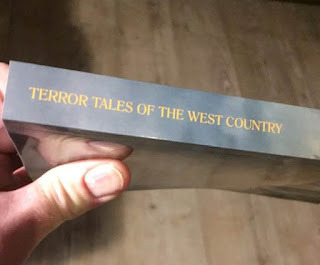 Out in the world
Out in the worldYes, TERROR TALES OF THE WEST COUNTRY is finally out there, it’s an actual thing, it is moving around in the hands of readers and reviewers alike (for proof of the latter, check out the unfolding response on the excellent VAULT OF EVIL , truly one of the best horror anthology review sites in the world). It’s also, as you can see from this pic, a solid chunk of a volume, easily the fattest of the series to date (primarily because it contains several truly wonderful but longer-than-usual stories).
Hopefully, people will enjoy this one as much as they’ve enjoyed the others.
TERROR TALES OF THE WEST COUNTRY is the 14th volume in the series thus far. Those who’ve followed them from the beginning will know that I first began editing these books in 2011, when they were published by Gray Friar Press.
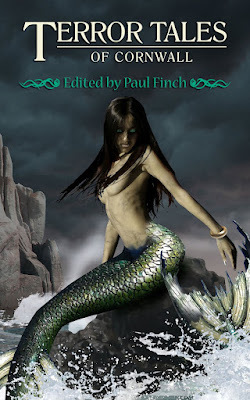 However, five years ago, with
TERROR TALES OF CORNWALL
, the operation was taken over by
TELOS PUBLISHING
.
However, five years ago, with
TERROR TALES OF CORNWALL
, the operation was taken over by
TELOS PUBLISHING
. The original intention behind the series was to make a whistle-stop tour of the UK, each anthology focussed on a different geographic area, the stories all linked to that region’s unique folklore, mythology and history.
And to date, the writers have done me very proud indeed, with numerous stories chosen for Year’s Best type editions and so forth. The books have also boasted a succession of truly wonderful covers, provided at first by Steve Upham, but later on, for the nine most recent editions, by Neil Williams, all of which have caught the eye far and wide.
The idea first came to me, believe it or not, back in the 1970s, when I was on holiday in the Lake District, where I acquired several volumes of the Fontana series, Tales of Terror, most of which were edited by R. Chetwynd-Hayes, and even though I was only a teenager at the time, I was so impressed that I just knew I had to do something similar when I was older.
Anyway, to cut a long story short, TERROR TALES OF THE WEST COUNTRY is now out in the world. So … come on, you guys. Go and get it.
When crime meets art
I’ve also been busy this last couple of weeks with a project I can’t talk about too much yet, though I hope to be very voluble about it indeed later this month.
Anyone who follows me online generally will know that NEVER SEEN AGAIN , my most recent crime thriller, has been chosen as the subject for an arts competition in Birmingham, the painters participating each charged with producing their own interpretation of the novel. As I say, I can’t be too vociferous about this yet, but you can read a little bit more about it HERE and HERE if you want to.

Suffice to say that a film crew came up to my home town of Wigan at the end of October, to interview me about it, to talk about the inspiration behind NEVER SEEN AGAIN , and behind my writing in general, and of course, the fusion of two very different art forms, painting and writing as part of a process, which ultimately must see 130,000 words of text condensed down into a single canvas (some challenge, when you consider it).
Anyway, above is a shot of me being interviewed on the matter by West Midlands media personality, the lovely Lorraine Olley. It was a great day when we did this. I can’t wait to tell you folks all about it. Stay tuned.
THRILLERS, CHILLERS, SHOCKERS AND KILLERS …
An ongoing series of reviews of dark fiction (crime, thriller, horror and sci-fi) – both old and new – that I have recently read and enjoyed. I’ll endeavour to keep the SPOILERS to a minimum; there will certainly be no given-away denouements or exposed twists-in-the-tail, but by the definition of the word ‘review’, I’m going to be talking about these books in more than just thumbnail detail, extolling the aspects that I particularly enjoyed (I’ll outline the plot first, and follow it with my opinions) … so I guess if you’d rather not know anything at all about these pieces of work in advance of reading them yourself, then these particular posts will not be your thing.
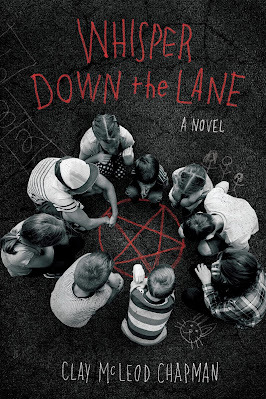 WHISPER DOWN THE LANE
by Clay McLeod Chapman (2022)
WHISPER DOWN THE LANE
by Clay McLeod Chapman (2022)
Outline
We enter this dark drama, which of course, is inspired by true-life incidents, in two different time streams. First of all, we join contemporary art teacher, Richard Bellamy, at a cute suburban school in Danvers, Massachusetts, where not only does he command the affection of his pre-teen pupils and the respect of most of the other staff, he’s recently entered into a relationship with another teacher, the slightly punky Tamara, and is now in the process of winning the trust of her son from a previous marriage, Elijah.
However it’s not all peachy. We open with Richard coming into work on his birthday, and finding one of the school’s pets, a rabbit called Professor Howdy, dead on the sports field, having been mutilated in gruesome, near-ritual fashion. Not only that, a birthday card has been inserted into its stomach cavity, which, when Richard opens it, says simply ‘Circle Time’, which he assumes refers to the team-building exercise the school’s staff usually indulge in each time before commencing work, though the incident remains horrible and baffling.
Richard is a relatively new teacher in Danvers, but apart from the endless scrutiny he inexplicably receives from beady-eyed principal, Mrs Condrey, he is very happy. The school is hardly a challenge; Danvers, which was once solid rustbelt, has been ‘Disneyfied’ in keeping with the modern politically-correct age. He thus tries to focus on his work and his relationship with Tamara and Elijah, but the rabbit incident won’t leave his mind, especially as there has recently been an uptick in the amount of graffiti appearing on the school’s toilet walls, including Satanic images like ‘666’.
The next moment of unpleasantness is more mundane. Elijah gets in trouble for hitting another kid, supposedly in defence of a pretty but withdrawn pupil called Sandy. It’s not a big deal, but while Richard is sorting it out, he receives a curious phone-call, someone breathing at the other end of the line but refusing to speak …
Switching back to 1983, we meet a nervous young child called Sean Crenshaw, who, in company with his highly-stressed mother, is fleeing their family home and starting a completely different life in a town they’ve never been to before. Greenfield, Virginia.
We quickly gauge that Sean’s mother is seeking to escape an awful relationship back home, and determined to make a clean break. At first it looks as though she’s succeeded, working more than one job to get herself and her son afloat again, Sean enrolled at the local school, Greenfield Academy, and when school is out, being minded by kindly neighbours. One of these in particular, Miss Betty, is especially helpful. While he’s in her house one day, Sean sees a faded photograph of a little boy who he’s never met in real life. Miss Betty tells Sean that this is her son who died, but because of the poor quality image, Sean comes to think of him as the ‘Grey Boy’ and finds the picture disturbing.
Even aside from this, Sean’s life in Greenfield is not all it might be. Once the word gets around school that he and his mother are welfare cases, other kids start to mock and bully him. When a particularly mean specimen called Tommy Dennings leaves bruises on his body, Sean’s mum, who is under pressure herself from the authorities regarding her own parenting skills (presumably owing to events in their former life), demands an explanation, but Sean is too frightened to tell her the truth. At the same time, he speaks a lot about his favourite teacher, Mr Woodhouse, who is young and energetic and disguises many of his lessons as games, and his mother begins to wonder exactly what their relationship is. Sean is equally stressed because though he insists that everything is all right and that he really likes Mr Woodhouse, he suspects that he’s not giving his mother the answer she wants.
Then the word gets out that Mr Woodhouse has been playing a game with the kids called Whisper Down the Lane, a kind of Middle-American version of Chinese whispers. In itself it’s harmless, but then, one of the messages he has his pupils pass from one to the next refers to Lucky Charms, a range of marshmallows currently disapproved of by a local group of watchful mothers, who are concerned about the supposed pagan symbology contained within the branding.
Rumours start spreading that something may be wrong at Greenfield Academy. Some children have been having bizarre nightmares (though they’ve never admitted that these occurred after they’d watched the Michael Jackson video, Thriller ), while others talk a lot about the many games Mr Woodhouse likes to play with them. Under heavy pressure from his mum, Sean finally cracks and tells a whopping lie, namely that their teacher likes to play a game called Horsey, in which they are all naked …
Back in the present day, Richard Bellamy’s odd experiences continue. During one lesson, he has the children make pinatas out of papier-mâché. Most create images of animals, but at the end of the lesson, he finds one that seems to represent a young child. It’s also been painted grey. No one in class will admit to having made it, and Richard then notices that someone has signed it ‘Sean’. Of course, there is no one in his class with that name.
Another name now occurs to him, seemingly from nowhere. ‘Mr Yucky’.
Later on, he is cheered up when Tamara offers to let him use her old garage as an art studio. Richard gave up painting some time ago, but now starts over, immediately sketching an image of a beautiful woman with a grey-toned boy in the background. He thinks the picture could represent his mother, who was very pretty, but it might also depict a beautiful woman called Miss Kinderman, a psychiatrist who once introduced him to a doll that was similar in looks to a Cabbage Patch Kid. Its name was Mr Yucky, she told him, and it was called that because he could tell all his yucky stuff to it.
Increasingly wondering what is happening and why these strange half-memories are bombarding him, Richard then loses Elijah at the Fall Harvest Fair. It didn’t help that he was fleetingly mesmerised by the sight of Mr Stitch, the grey-faced scarecrow at the heart of the corn maze. Thankfully, Elijah is located safe and well by Sandy’s mother, Jenna Levin, a handsome but rather humourless woman, who doesn’t seem to like Richard by instinct. Inevitably, Tamara, who gets extremely angry very easily, is unimpressed.
As she drives them home fast, ranting and raving, Richard is reminded of his own mother, when he was a young boy, driving them at dangerous speed away from their old life to a town called Greenfield. When they get home, he finds the cat, Weegee, hanged and gutted. Not wishing to fuel the atmosphere with further anxiety, Richard conceals the carcass in his studio. Then he notices an item of mail that arrived earlier that day. It is addressed to ‘Sean’ and when he opens it, contains a single newspaper clipping. It is at least two decades old, and discusses the fate of a former teacher called Thomas Woodhouse, who, despite having recently been acquitted on appeal of ritually abusing his pre-teen pupils, has still served extensive prison time, and has now committed suicide …
Back in the early ’80s it’s all hands to the pump as the school kids, taking their lead from Sean, and at the coercive behest of their parents, tell lies about Mr Woodhouse. Miss Kinderman is a key instigator, using various eccentric methods to get Sean to open up even more, dressing as a scarecrow on one occasion, but mostly utilising the hideous grey doll, Mr Yucky.
The stories have grown with the telling. Mr Woodhouse wasn’t acting alone. Other members of the faculty were involved too, and sometimes the children were taken out of school to attend Black Masses in derelict graveyards. All kinds of vileness was indulged in. Inevitably, when Mr Woodhouse goes on trial, Sean is the star witness. It hurts him deeply that he’s continuing to tell bare-faced lies. He knows it’s very wrong, but this is what Miss Kinderman, and more importantly, his mother seems to require from him.
Afterwards of course, Sean and his mother become the centre of all conversation. People are now sympathetic to them. At last, they seem to have friends. Though not everyone commiserates. When a brick is thrown through Sean’s window, he senses that it’s an unhealthy kind of attention people are paying to them. When the part of the school where Mr Woodhouse used to teach is burned down, he detects the mob mentality lurking beneath the surface of the townsfolk.
Very much against his will, but still playing along, Sean is invited to appear with his mother and Miss Kinderman on a popular television talk-show. During the course of a sensationalist TV circus in which no lurid detail is left unaired, Sean is semi-hypnotised by the sight of the Grey Boy, who sits in the audience and waves at him …
Back in the present, we now know for certain that Richard Bellamy and Sean Crenshaw are one and the same. Richard thought he’d put Sean – the Grey Boy, the Cabbage Patch Kid – away, tucked him into the back of his brain, and had forgotten him along with that whole terrible period of his early life.
But someone else – God only knows who? – clearly hasn’t forgotten, and it seems they are determined to raise the Satanist terror all over again, this time in Danvers, and to put another popular teacher, Richard Bellamy, at the centre of it …
Review
The infamous Satanic Panic originated in 1980 with the now discredited memoir, Michelle Remembers , in which a Canadian psychiatrist, Lawrence Pazder, claimed that, while treating a patient called Michelle Smith for depression, he unlocked repressed memories of horrific abuse suffered during childhood in the midst of brutal Satanic ceremonies. The book became a huge seller, mainly through the shocking possibility that ordinary, everyday children might be suffering the most depraved forms of ritual abuse, not just at the hands of perverse and twisted parents, but while in the safekeeping of so-called care-workers. This appalling fear was exacerbated three years later by the McMartin Pre-School trial in Manhattan Beach, Los Angeles, wherein allegations were made (again, most of which were later refuted) that pre-teen children had been taken to Black Masses by kindergarten staff, where they had suffered torture, rape and been forced to watch animal mutilation and human sacrifice.
Rumours wildfired that such incidents were not isolated and were in fact the work of an organised, international cabal of devil-worshippers, whose very raison d’être was to do the most evil things imaginable, including the murder and molestation of infants. This ‘moral panic’ as it became known, eventually swept the US and much of the rest of the western world, engulfing entire towns, and creating a latter-day witch hunt of terrifying size and scope, which caused the break-up of families and communities, and the jailing of numerous individuals, many of whom, though they were later exonerated, would feel like outcasts for the rest of their lives.
It’s not essential that you know this in order to fully appreciate Whisper Down the Lane , but it can only help if you do. Because what Clay McLeod Chapman has done with this book is create an enthralling mystery-thriller set against that simmering background of fear and paranoia.
It’s a fictionalised version of the real events, of course, but it’s no less powerful for that.
The storyline set in the 1980s sees the Greenfield Academy standing in for the McMartin Pre-School day-care centre, with the fictional teacher, Tom Woodhouse, at the centre of the allegations in place of Ray Buckey, the main member of the accused in real life (who was finally released from prison, all charges against him dismissed, though by this time he’d served five years!). Sean Crenshaw’s mum meanwhile is in place of Judy Johnson, the real-life disturbed mother who first became convinced that her child had been abused and thus kickstarted the McMartin calamity, while one Manuel Cassavetes, a fictional talk-show host, takes the place of Geraldo Rivera and Oprah Winfrey, who both dealt with the issue on their programmes but challenged few, if any, of the claims made by the so-called victims. Other characters in the novel, such as investigating psycho-therapist, Miss Kinderman, are composites of the various clinicians, social workers, detectives and journalists who were later severely criticised for encouraging belief in a nightmarish fantasy.
Though one might accuse the author of tastelessness in his selection of a historic but relatively recent tragedy around which to weave his menacing tale, this is negated in my view by the seriousness with which he takes the subject-matter and by his absolute determination to replicate the injustice of those dark days, but also to investigate how it might have come about.
That isn’t to say that Chapman doesn’t play the odd mischievous prank on us. Several of his characters share names with key characters in famous works of demonic-horror fiction (and even the actors who portrayed them), while certain phrases and figures of speech are also reminiscent. On one reading alone, I singled out The Exorcist , Rosemary’s Baby and The Omen . Again though, I feel this is more than just a homage to a genre that Chapman obviously loves, the cross-referencing here implying that the Satanic Panic was at least partly rooted in the conviction these very compelling works of fiction had managed to create in certain parts of society that the Devil is real and his demons a powerful force in the world.
However, your belief or unbelief on this matter should be immaterial to your enjoyment of Whisper Down the Lane , because neither the Devil nor any of his minions make an appearance in it.
They don’t need to.
One of several subtexts here is the danger posed by zealous belief. Whether this stems from religious fundamentalism or a simple inability to understand our vicious and chaotic world doesn’t really matter, because belief on its own – particularly unquestioning belief – can be a very negative force, especially when it leads to an assumption of righteousness. It doesn’t even need to be religious. The 20th century was the bloodiest century in human history, and most of the atrocities committed then were the result of political fanaticism.
But it’s religion we’re dealing with in Whisper Down the Lane , or rather a distortion of it, because that is what happened during the Satanic Panic, and the entirety of that ghastly episode is very neatly encapsulated by Chapman in this relatively short novel, wherein it’s mostly seen through the eyes of a single individual, Richard Bellamy, who, in a very clever move by the author, happens to have been both the perpetrator of such hysteria back when he was an untruthful child, and the victim of it, when, as an adult, he becomes implicated in villainy by a malicious whispering campaign rather than anything concrete.
Which brings us to the other big talking-point in the book: paranoia and mob rule.
Where does it come from? How can it still be a thing in an educated age?
The author doesn’t offer any firm answers, but makes a few suggestions.
The easiest way to engineer widespread paranoia, even in modern times, is to infect the common herd with anxiety that their lifestyle might be under threat. Hence another Danvers teacher, Miss Gordon’s suspicion that the Sandy Hook massacre was a hoax and all part of a government plan to deprive American gun-owners of their weapons. But it really becomes incendiary when there’s an apparent threat to the young. Even the most liberal-minded parents will argue that they can’t afford to ignore suspicions like those, and that any menace to their children, no matter how seemingly improbable, must be guarded against. All of a sudden, you don’t need to prove that Mr X or Miss Y is a wrong ‘un. You just want them gone … it’s that simple. And once you’re in that state of mind, any vague oddity about this suspicious person will bolster your determination.
Chapman works this idea particularly cleverly by putting us, the readers, into the same frame of mind via the device of Richard’s lover, Tamara, who ostensibly is one of the good guys, but who has a violent temper and a mysterious past in her own right, not to mention something of a counterculture aspect, her body bearing a serpentine tattoo so sinister that she covers it up during the day, plus a tattooed thistle, which she claims is to help her ‘break hexes’ … all of which, at least as far as I was concerned, makes her a potential suspect in the Danvers wave of Satanic outrages.
It’s neat work by the author, showing us that we too can be deceived by appearances and attitudes that differ slightly from the norm.
With all these big issues up for discussion, the actual thriller element of Whisper Down the Lane seems a little inconsequential, but in Chapman’s hands it’s not just a framing device for a polemic. It works very well on its own merits, and is crisply and sparingly written, with many twists and turns, all of them delivered smoothly and perfectly timed. The scarecrow factor, not to mention the Grey Boy, even take us a little way into the world of horror, though the author doesn’t overdo this, keeping us firmly in the real world.
Richard’s gradual breakdown is especially well-done. We know the character inside-out by this time, having travelled in his head on two particularly difficult journeys, and sense his trauma without having it thrust in our face. It’s inevitable around this part of the book, primarily because by now you’ve really pegged Richard for the most unreliable of narrators, that you begin wondering if he isn’t so innocent after all, if he’s perhaps so deranged by his earlier experiences that he’s finally embarked on the crime-spree he only imagined all those decades ago. This loads the narrative with additional tension and suspense, which has you flipping pages like nobody’s business, desperate to find a resolution you can live with.
It was always going to require bravery, writing a novel like this. Many wounds inflicted by the real-life Satanic Panic are still raw, while there are some parts of the world where it hasn’t yet ended (the advent of the Internet and the exposure of organised online paedophilia has led some to wonder if law enforcement was too quick to dismiss the unproven claims that networks of ritual child-abusers existed in the 1980s, and it has certainly increased modern-day parental anxiety about adult acquaintanceships with their kids), but in Clay McLeod Chapman’s hands, it’s all done subtly and intelligently, with minimal sensationalism and a clear understanding that this was, and still is, a massive issue to which there is no painless resolution.
Even the pop culture references to famous novels and movies has a serious side to it: hinting that the Devil – or any other icons of supernatural evil, any monster, demon or ghost – doesn’t necessarily need to exist to become an actual entity in our lives. All it takes is for people to believe that he does.
As usual now, in the event of a TV or movie version of Whisper Down the Lane, I’m going to pre-empt the casting department by nominating some actors of my own. However, I’m under no illusion that, because of the subject-matter alone, this would be a difficult and controversial adaptation to mount, and even though nothing salacious ever happens on the written page, I’m not even going to think about naming any child-actors. As for the adult cast, well, as usual, money is no object.
Richard – Miles Teller
Tamara – Zoë Kravitz
Tom Woodhouse – Ezra Miller
Miss Kinderman – Margot Robbie
Mrs Crenshaw – Melissa George
Manuel Cassavetes – Tom Ellis (see what I did there?)
Published on November 08, 2022 08:56
September 30, 2022
TERROR TALES OF THE WEST COUNTRY
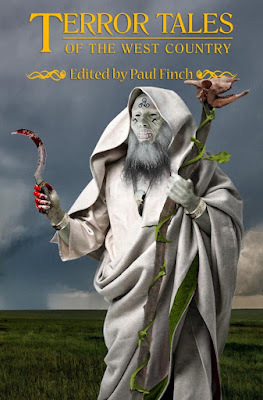 Well ... October just around the corner, eh?
Well ... October just around the corner, eh?The season of mist is definitely upon us. So, it’s probably a very good time to talk about the next volume in the TERROR TALES series, which, as you can see here, is TERROR TALES OF THE WEST COUNTRY.
Okay, I know you’ve all been waiting for this one. And don’t worry; if you always associate the West Country with sunshine, hay riggs and the green fields of summer, and now, all of a sudden, we’re into the realm of darkness, falling leaves and jack-o-lanterns, be assured that facades can be deceptive. There is an awful lot of spookiness going on in the West Country, and especially in this new anthology.
Just keep reading for the full Table of Contents, the back-cover blurb, a few choice snippets from selected stories, and full details of how you can pre-order HERE.
In addition to that treat, and fully in keeping with the fact that Lisa Tuttle, that British queen of the mysterious macabre, makes her debut in this volume in the series, I’ll also be reviewing her exceptional novel, THE MYSTERIES, a wonderful work of folk-horror in its own right.
If you’re only here for the review of Lisa’s book, you’ll find that, as always, in the Thrillers, Chillers section at the lower end of today’s blogpost.
Before that though, let’s get into …

This is of course the latest in a long line of regional folklore-inspired horror anthologies that I’ve edited (firstly for Gray Friar Press, but this time and for the last several in fact with TELOS PUBLISHING ), all stemming from my lifelong fascination with ghost and horror stories, regional lore and folk-mysteries, and the most ancient and unexplained aspects of Britain’s landscape and culture.
If you want to check out the other books in the series so far, go HERE . If you want to proceed with this one, let’s get on with this …
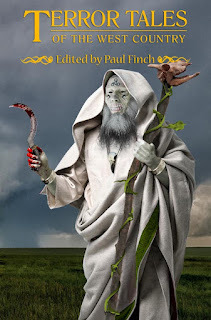 The West Country. England’s mystical heart. Hill-forts, ancient circles. Blessed by age-old powers, sanctified in blood. Where woods and pools stir to whispered summonings, forbidden names are carved in rock, and rebels died en masse, hanged and butchered, their gore-dabbled ghosts wandering vengeful in the rural night …
The West Country. England’s mystical heart. Hill-forts, ancient circles. Blessed by age-old powers, sanctified in blood. Where woods and pools stir to whispered summonings, forbidden names are carved in rock, and rebels died en masse, hanged and butchered, their gore-dabbled ghosts wandering vengeful in the rural night … The drumming demon of Tedworth
The ocean predator at Ilfracombe
The sleeping bones at Wilcot
The creep-about killer on Burgh Island
The hateful entity in Cheddar Gorge
The flesh-rotting curse at Blackdown
The stalking spectres on Dartmoor
Includes terrifying stories by AK Benedict, Andy Briggs, Mike Chinn, Adrian Cole, Dan Coxon, Steve Duffy, Paul Finch, Lizzy Fry, John Linwood Grant, SL Howe, Thana Niveau, John Llewellyn Probert, Sarah Singleton, Lisa Tuttle and Stephen Volk.
TABLE OF CONTENTS
The Darkness Below by Dan Coxon
Unto These Ancient Stones
Objects in Dreams May Be Closer Than They Appear by Lisa Tuttle
The Horror at Littlecote
The Woden Jug by John Lindwood Grant
And Then There Was One
Chalk and Flint by Sarah Singleton
When Evil Walked Among Them
Epiphyte by Thana Niveau
The Hangman’s Pleasure
In the Land of Thunder by Adrian Cole
The Thing in the Water
Unrecovered by Stephen Volk
Priests of Good and Evil
Gwen by SL Howe
The Pixie’s Curse
Watcher of the Skies by Mike Chinn
Vixiana
Bullbeggar Walk by Paul Finch
The Tedworth Drummer
The Pale Man by Andy Briggs
By the Axe, He Lived
Little Down Barton by Lizzie Fry
Hounds of Hell
Certain Death for a Known Person by Steve Duffy
The Blood Price
Knyfesmyths’ Steps by AK Benedict
Lonesome Roads
Soon, the Darkness by John Llewellyn Probert
And if that didn’t wet your whistles sufficiently, here are several uber-discomforting excerpts.
The old moss woman stepped out from the side of the lane and stood in front of her. Still in threadbare wintery apparel, she was all rotten wood bones beneath the lush moss cloak. Her hair was long and white, bedraggled strands of last year’s grass around a face of dark, yawning gaps and hollows …
Sarah Singleton – Chalk and Flint
‘What are you getting at?’ For the first time since my arrival at High Thornhays I was on the defensive. Old habits born of inadequacy coming to the fore; truculence, sullenness … and just the beginnings of fear. The man with no face there in the armchair: I was already afraid of him. Not nearly as afraid as I ought to have been, not yet. But soon; very soon.
Steve Duffy – Certain Death for a Known Person
Holes had been poked for eye sockets. The blackened lumps of something moist that had been pushed deep within the ragged cavities now regarded him soullessly. It was the kind of weird nonsensical thing that under normal circumstances would be funny but here, in this desolate place, with the chill and the damp worming their way between the folds of his clothes, the idea of some mutant horse-thing hobbling across the landscape on its hind legs wasn’t remotely amusing.
John Llewellyn Probert – Soon, the Darkness
The TERROR TALES series is one of the best things that’s ever happened to me throughout my time in dark fiction. I’ve derived limitless pleasure from working alongside and becoming very friendly with a vast number of immensely talented authors from a range of disciplines (crime, thriller and historical as well as horror and fantasy), almost all of whom (with only one or two rare exceptions), have totally bought into what I’ve tried to do with these books, and have given it their very best shot. With luck, there are lots more titles in the barrel yet, and many, many more writers for me to invite to participate.
But in the meantime, everything is focussed on TERROR TALES OF THE WEST COUNTRY , which will be published around Halloween but which you can pre-order RIGHT NOW .
*
 Before we get to today’s book review, a quick reminder about
THE DEAD TIME
.
Before we get to today’s book review, a quick reminder about
THE DEAD TIME
. This is an all-in-one collection of four of my books, each one related to a different scary aspect of the waning year, and it can be purchased now on Kindle or Audible RIGHT HERE .
*
THRILLERS, CHILLERS, SHOCKERS AND KILLERS …
An ongoing series of reviews of dark fiction (crime, thriller, horror and sci-fi) – both old and new – that I have recently read and enjoyed. I’ll endeavour to keep the SPOILERS to a minimum; there will certainly be no given-away denouements or exposed twists-in-the-tail, but by the definition of the word ‘review’, I’m going to be talking about these books in more than just thumbnail detail, extolling the aspects that I particularly enjoyed (I’ll outline the plot first, and follow it with my opinions) … so I guess if you’d rather not know anything at all about these pieces of work in advance of reading them yourself, then these particular posts will not be your thing.
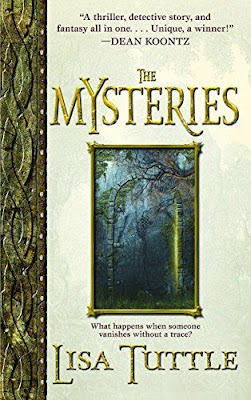 THE MYSTERIES
by Lisa Tuttle (2005)
THE MYSTERIES
by Lisa Tuttle (2005)
Outline
We open with Ian Kennedy, an ex-pat American living in London who just about earns a living as a private eye, his speciality pursuing and finding missing persons. A tricky way to make ends meet, you might think, but this vocation is pretty much hardwired into him thanks to a series of incidents in his past during which loved ones dropped out of sight.
For example, one day when he was a child, during a family daytrip, Kennedy’s father disappeared right in front of his eyes. In later years, when he was living happily with girl-of-his-dreams, Jenny, she too vanished, simply winked out of existence just when he thought they couldn’t have been happier together. In both cases, these seemingly unaccountable mysteries were resolved by Kennedy when he finally got his investigator head on, and in truth, and perhaps sadly, there were no extraordinary circumstances: it was all very mundane and centred around selfishness and sex.
However, both disappearances made such an impression on Kennedy that they set him on a course in life he has never rejected since, so much so that he’s become very good at finding missing people. He’s also become very open-minded, because one of his earliest commissions sent him up into the Scottish Highlands, where, amid the mist and pine-trees, he found himself on the trail of a young woman who might have been abducted into the ‘Other World’ … and that would be the real Otherworld, the hidden land of mysterious spirits once known as faeries.
It all may sound implausible, as fantastical a memory as the delusion Kennedy lived under that his father had dropped out of this world through some kind of dimension door when in reality all he’d done was move in with his mistress, but rushing back to the present day, we now find Kennedy recruited by another American living in London, the attractive and wealthy Laura Lensky, whose daughter, Peri, also vanished during a bizarre and inexplicable occurrence.
This was two years ago, and the police have never really been interested. To them, Peri was an adult and adults can drop out of sight if they wish, and this seems especially likely when there is no evidence at all of foul play. However, Peri’s posh ex-boyfriend, Hugh Bell-Rivers, a guy who, to all intents and purposes, has now moved on with his life and even has another girlfriend, tells a different story.
He struggles to recollect criminal activity, but still recalls a chilling event, explaining how he and Peri attended an eerie nightclub in the heart of London (in a tremendously skin-prickling scene), where they met a handsome, charismatic stranger called Mider, who seemed to be particularly taken by Peri, while she, in turn, was semi-entranced by him, and how, even though Peri was later delivered safely home by Hugh, she went missing the following day, and when he went back to the nightclub, it was no longer there.
Any ordinary PI might take such a story with a pinch of salt, working on the basis of drugs or too much drink, and respond in the same indifferent way the police did. But Kennedy has been around. He’s heard about Mider before, too. The guy is a legend. Literally. A renowned seducer and abductor of women, but he is only supposed to exist in Celtic mythology …
Review
Lisa Tuttle’s The Mysteries is a strange kind of beast. Sitting triangulated somewhere between horror, thriller and fantasy, it packs a unique punch, asking all sorts of questions about the human condition, how our hopes and fears can affect our perceptions of reality, how loss and betrayal can permeate through the rest of our lives, changing us completely, sending us in totally different directions, but at the same time it hits us with an intriguing and suspense-filled mystery, which, from the very beginning has a possible supernatural explanation (which I personally thought made it all the more enthralling).
Of course, mystery lies at the core of this story. Even between chapters, Lisa Tuttle treats us to short, skillfully-told anecdotes about famous disappearances in history, some of which were later resolved, but many of which, most of them in fact, are rumoured to have been the work of the faeries, a race of enigmatic beings who, in mythology, had nothing to do with Victorian nursery books but were the occupants of an alternate world to ours, whose moods and motivations were completely unknowable to humans, and yet who were so fascinated by mortals that they would regularly cross over and take them captive.
We hear about Corporal Armando Valdes Garrido of the Chilean Army, who in 1977 disappeared in front of his men, only to reappear fifteen minutes later, unable to explain where he had been and yet sporting a five-day growth of beard. And Eliduras, the 12th century priest who was tortured for the rest of his days by childhood memories of entering a wondrous land through a portal under a tree, which he was never again able to find. And even the famed quartet of lighthouse keepers, Joseph Moore, James Ducat, Donald McArthur and Thomas Marshall, who in 1899 vanished from the remote Eilean Mor lighthouse without explanation or trace.
All of this is counterbalanced to a degree by the prosaic solutions provided for the disappearances of Ian Kennedy’s father and later on his girlfriend, Jenny Macedo. Not that these aren’t also mysterious events in their own way, or compellingly handled by the author (as well as showing great emotional depth). A couple of reviewers have criticised the otherwordly elements in The Mysteries , pointing out that Fairyland, for want of a better term, if it exists at all, is supposed to be unreachable by humans and that Ian Kennedy, though he’s already overcome the immense obstacle of not knowing whether to believe in it or not, makes contact with this curious realm far too easily. My response to that would be that Lisa Tuttle is only reflecting the many myths of Britain and Ireland, wherein ordinary, everyday people unintentionally blunder into this fantastical place, or at least make contact with its denizens by accident (unless those denizens themselves want it to happen, in which case those ‘accidents’ can easily be engineered).
Another argument presented by naysayers is that it’s all too implausible and that, in The Mysteries , we are simply asked to believe the unbelievable, namely that the Otherworld is real, and that magical beings known as the Fae, or the Faerie, or fairies, genuinely exist, and that everyone in this narrative buys into it far too quickly, which is all the more odd given that Ian Kennedy is supposed to be a private investigator, the sort of hardnosed bloodhound who would normally be chasing wanton wives and absentee husbands. But again, there’s an answer. If you want a hardboiled detective story set in the world of Noir, don’t read The Mysteries . Likewise, if you want a police procedural or an actioner, go somewhere else.
As I’ve already said, from its outset, this novel makes it clear that we are on the edge of a fantasy kingdom, and this despite the down-to-Earth elements of Kennedy’s father’s callous abandonment of his family, Jenny Macedo’s unfaithfulness, and even the cold, rain-wet London streets where our hero spends most of his time.
If because of this, you are only half-and-half on whether or not to read The Mysteries , I would urge you to proceed. Because the real joy of this book is Lisa Tuttle’s writing style. It’s very smooth and hugely accessible, everything clipped down to its crisp basics but penned with a real flourish so that it’s a pleasure simply to read it, the pages flipping by effortlessly. In addition to that, though it’s not a complex mystery (not by other PI novel standards), the overarching story that The Mysteries seeks to tell could be overly complex if it wasn’t for the masterful way that Tuttle constructs it. The various events of Ian Kennedy’s life, not just his own odd experiences as a young man back in the States, but his first investigation up in Scotland (the one that persuaded him there are more things in Heaven and Earth), and then the main one, the pursuit of Peri Lensky, run in parallel strands, which are timed to perfection and complement each other marvellously.
All in all, The Mysteries is a thoroughly engaging and entertaining read: a fantasy, yes, but without the extreme aspects of that genre that some readers might find offputting; a thriller too, but without the terror and violence and blood (though this doesn’t mean there aren’t some intense moments of creeping dread – oh yes, there is evil afoot, even in Fairyland).
I stumbled upon this book by accident, and I’m really glad I did. In The Mysteries , Lisa Tuttle has given us a very different, very sophisticated but, above all, very enjoyable kind of mystery. I recommend that you avail yourself of it right away.
I’m now going to commit my usual folly of attempting to cast this piece before someone out there in film or TV land gets smart enough to do it for real. Just a bit of fun, of course, but here’s who I’d use:
Ian Kennedy – Tom Payne
Laura Lensky – Amy Adams
Hugh Bell-Rivers – Dean-Charles Chapman
Mider – Claes Bang
Jenny Macedo – Ruth Negga
Fred Green – Elizabeth Debicki
Published on September 30, 2022 00:37
September 24, 2022
Get your autumn and winter scares FREE

Okay, well my overseas ramblings are done for 2022 and I return to an England already rich in autumnal flavour. Yes, the leaves appear to be turning orange quite early this year, the mist is rising and the long, dark nights are already drawing in.
As we say, at roughly this time each September, the atmosphere is ripening for very scary stories. And who am I to disappoint on that score?
So, this week I want to focus on a new publication of mine, which has recently become available on Audible and Kindle: THE DEAD TIME, 4 Books for the End of the Year.
As you can probably see from the image, it’s a collection of four books in one, two novellas and two collections of stories, all themed for the darker end of the year, a bumper pack of eerie tales set between (and incorporating) autumn and Christmas.
However, these are re-releases.
I want to make that crystal clear straight away.
The four books contained in THE DEAD TIME have all been published before individually, and so you may already have read them. Of course, that doesn’t mean that if you haven’t, this won’t be a very enjoyable and cost-effective way to dive into them as a newbie … especially as we’ve devised a scheme by which you might be able to get hold of the Audible version of THE DEAD TIME absolutely FREE.
But more about that a little later. First, also this week, again in keeping with the overarching theme of terrifying tales, I’ll be reviewing Reggie Oliver’s wonderful collection of short stories, FLOWERS OF THE SEA , yet another smorgasbord of bone-chilling delights from one of Britain’s current true masters of the scary short story.
If you’re only here for the Reggie Oliver review, that’s absolutely fine. Just zoom on down to the end of this blogpost, where, as always, you’ll find it in the Thrillers, Chillers section. However, if you’re also interested in sampling some of my own output, stick around a bit first, and let’s get acquainted with …
The waning of the year
I won’t bore you all by blathering on again about how much I love ghost and horror stories, and how each year the gradual descent into autumn and winter stirs a new yearning inside me to both read and write within that genre. Suffice to say that yet again, we are there … it’s that time of year, and as usual my head is firmly in that ghostly realm.
But even more so this year, as I’ve got something exciting and relevant to put out there.
As already stated, THE DEAD TIME is a collection of four books in one, two novellas – SEASON OF MIST and SPARROWHAWK , and two collections of Christmas ghost stories, IN A DEEP, DARK DECEMBER and THE CHRISTMAS YOU DESERVE .
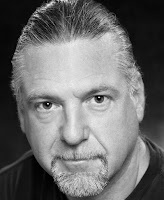 As I mentioned previously, all have been published before, but all four also got the Audible treatment courtesy of actor and narrator par excellence, (left), who performed these titles the first time around, and recently suggested re-issuing them under a single umbrella, giving any punters interested an opportunity to get hold of them all together and at a bargain price (or maybe even absolutely FREE).
As I mentioned previously, all have been published before, but all four also got the Audible treatment courtesy of actor and narrator par excellence, (left), who performed these titles the first time around, and recently suggested re-issuing them under a single umbrella, giving any punters interested an opportunity to get hold of them all together and at a bargain price (or maybe even absolutely FREE).And so, again, who was I to disappoint?
Here is the finished product, THE DEAD TIME , available now either on Audible or Kindle, the amazing cover coming to us from the monumentally talented NEIL WILLIAMS.
I keep hinting that there’s a chance you can listen to it for FREE, and indeed there is. But I’ll only be revealing how you do that at the end of today’s post. Before then, here’s a bit of info about THE DEAD TIME ’s constituent parts, as seen in the original blurbs that appeared on the backs of their jackets.
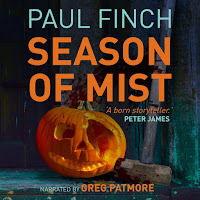 SEASON OF MIST (novella)
SEASON OF MIST (novella) Our last autumn of innocence. Star-spangled nights. Mist-wreathed woodland. A twisted shape watching coldly from the shadows.
Industrial Lancashire, 1974.
The kids in the coal-mining town of Ashburn love the waning of the year. Fancy dress and scary stories for Halloween. Fireworks and treacle toffee on Guy Fawkes Night. And a month after that, snow and the approach of Christmas.
But this particular autumn will be memorable for entirely different reasons.
Because this year someone is killing the children of Ashburn.
Or should that be SOMETHING?
While police and parents search for a maniac, Stephen Carter and his schoolmates know better. They may be on the cusp of adulthood, but there’s still enough of the youngster left in each of them to recognise the work of an evil supernatural being unique to these deserts of slagheap and coal-tip …
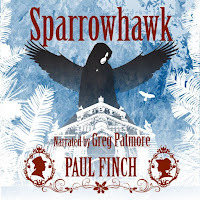 SPARROWHAWK (novella)
SPARROWHAWK (novella) In the year 1843, embittered Afghan war veteran John Sparrowhawk is released from the ‘prison by the beautiful and enigmatic Miss Evangeline.
Penniless and alone in the world, he takes employment with his mysterious benefactor, agreeing to stand guard over a house in Bloomsbury for the duration of the Christmas period.
But while London is gripped in the coldest winter in living memory, Sparrowhawk soon comes to realise that he is being stalked by a supernatural entity, whose terrifying presence is only partially cloaked by the mist and the snow and the gnawing winter darkness.
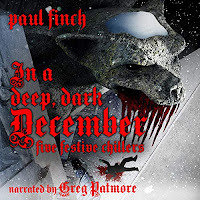 IN A DEEP, DARK DECEMBER (short story collection)
IN A DEEP, DARK DECEMBER (short story collection) Christmas. A time of feasting and good cheer. Gifts, cards, blazing holly logs. But it isn’t always joyful. It’s the coldest time of year. The days are short, the nights long, and chilling myths lie hidden behind the raucous revelry.
The ghoulish events in the frozen workhouse
The undead presence at the costumed ball
The pantomime that became a massacre
The winter goddess with the heart of ice
The thieves who woke the dark side of the festive spirit
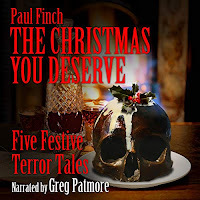 THE CHRISTMAS YOU DESERVE (short story collection)
THE CHRISTMAS YOU DESERVE (short story collection) Christmas, the happiest time of year. Plum puddings, candy canes, carols by the fireside.
But outside, the mist lies deep and still. Frost gnaws at your fingertips. Shadowy forms lurk in the evergreens.
It’s the season for ghost stories. For dark warnings. For eerie myths drawing on the blood rites of the past …
The Christmas present that wants to butcher you
The horned devil in the Santa Claus suit
The terrifying events at Mistletoe Hall
The movie makers trapped in a winter nightmare
The annual puppet show that ends in death
And now the bit you’ve all been waiting for. I’ve been suggesting throughout this blogpost that you might be able to get this title on Audible for absolutely NO CHARGE. Well, here’s how you do it:
I have 10 FREE Audible codes to give away, five are British and five American. All you need to do to go into the hat, from which I’ll draw the lucky winners next Friday afternoon, is find me on Twitter, follow me and retweet the tweet in which I publicise this same draw. It will open with the phrase: WIN A BUMPER CROP OF CHILLERS ON AUDIBLE.
THRILLERS, CHILLERS, SHOCKERS AND KILLERS …
An ongoing series of reviews of dark fiction (crime, thriller, horror and sci-fi) – both old and new – that I have recently read and enjoyed. I’ll endeavour to keep the SPOILERS to a minimum; there will certainly be no given-away denouements or exposed twists-in-the-tail, but by the definition of the word ‘review’, I’m going to be talking about these books in more than just thumbnail detail, extolling the aspects that I particularly enjoyed … so I guess if you’d rather not know anything at all about these pieces of work in advance of reading them yourself, then these particular posts will not be your thing.
 FLOWERS OF THE SEA
by Reggie Oliver (2013)
FLOWERS OF THE SEA
by Reggie Oliver (2013)
The sixth collection of short fiction from eloquent British wordsmith, Reggie Oliver, and another bang-up job by Tartarus Press, who are currently on a mission to showcase the best of weird writing in the most elegant fashion. By almost any standards, this is a pretty interesting collection, not least because you can’t categorise the whole of it as horror or even weird. There are strong literary efforts on show here too, not to mention some personal and moving introspection by the author, plus much that draws on his classical education at Eton.
Before we get into the nitty-gritty, I’ll let the publishers themselves introduce it in their own words. Here is the official back-cover blurb:
The sixth collection of ‘strange stories’ by Reggie Oliver follows the award-winning Mrs Midnight (2011). Oliver’s variety of subject matter, wit, characterisation and stylistic elegance are on display, as is his gift for telling a good story …
The rivalry between two former MI5 members in a seaside town escalates into something deeply sinister and mysterious. The one-time assistant to a musical genius is dying in early 19th century Vienna and cannot escape his obsession with their last collaboration. In Weimar Germany a mass murderer is awaiting his execution with perplexing eagerness …
There are two novellas in this collection. ‘Lord of the Fleas’ is a study of a sinister 18th century architect, told through various documents, including an unpublished fragment of Boswell’s ‘Life of Dr Johnson’, and a series of increasingly desperate letters from a young woman to her cousin in the style of the epistolary novels of Fanny Burney. The other novella, ‘A Child’s Problem’, inspired by a painting in the Tate Gallery by Richard Dadd, was nominated for ‘Best Novella’ in the Shirley Jackson awards of 2012 …
When most readers hear the name Reggie Oliver – and awareness of this fine purveyor of ghostly fiction is spreading very fast – they think the Jamesian school. That is ghostly material written in the style of MR James. Not just crisp, neat and concisely yet richly descriptive and characterised, but with a scholarly air, and tending to involve antiquarians or occultists meddling in age-old mysteries, and inevitably bringing upon themselves supernatural vengeance, the avenger often taking the form of a revenant, a semi-corporeal undead thing that has either risen from a place of entombment or been summoned from beyond, and which can wreak actual physical and even mortal damage on its human opponents.
This is not by any means the whole story with MR James, and likewise, Reggie Oliver doesn’t always plump for this. But Oliver enjoys his ghosts and his curses and his atmospheric Jamesian locations: old theatres or churches, isolated manor houses, or quiet rustic towns in East Anglia or France. In addition, as Dr James did, he enjoys frightening his readers, and has now become something of a past-master at that.
Fans of his will thus be delighted to know that there are a number of examples of all these things in Flowers of the Sea .
For example, the novella A Child’s Problem is set in Regency England, where an unwanted boy is despatched to the grand estate of his wealthy blowhard uncle. However, there are mysteries here, and maybe a ghost or two, and it soon becomes apparent that whatever vengeance is coming for the lord of Tankerton Hall, it will come from beyond the grave.
Similarly, Jamesian, though with a very modern twist, is The Spooks of Shellborough , in which a retired MI5 officer finds no peace in the quiet resort where he settles down in his dotage, especially when a former comrade turns up to sour the atmosphere. There is a dark history between these two going all the way back to the Troubles in Northern Ireland, involving betrayal, torture and murder, and it isn’t over yet.
But perhaps the most undeniably Jamesian tale in Flowers of the Sea is Between Four Yews . Given that this is one of the best stories Reggie Oliver has so far penned in my view, and also one of the broadest in scale, I’ll say a little more about this one later and will merely point out here that it concerns an unwise attempt to harness supernatural power and the terrifying consequences.
As well as MR James, Reggie Oliver’s most recent output has been likened to that of Robert Aickman, an author from a later era but another ‘strange’ story specialist, who didn’t concern himself with ghosts and ghouls as much as with macabre oddness often tinged with deviant psychology.
If you can picture an author who melds this approach with that of MR James, then you’ve probably got Reggie Oliver in one. The most Aickmanesque (if such a word exists) story in this book is also one of the best. Didman’s Corner concerns a bereaved man seeking to recover by hiring a cottage in a rural enclave he once called home. But another cottage nearby, one in a semi-ruinous condition, slowly starts stirring frightful memories.
Perhaps in keeping with the Aickmanesque spirit, in the Author’s Note at the back of this book, Reggie Oliver writes that while he has no objection to being classified as a ‘horror writer,’ he is less interested in such horror tropes as blood and mutilation (though he won’t shy away from gruesomeness if it’s required), and more attracted to the ‘metaphysical dimension’.
Well, that might be the case, but humble as Reggie Oliver is, he can still do horror better than many other practitioners in the field.
For example, in Charm , an Oxford don and his wife rent a Cotswolds manor house, but don’t realise how closely this will bring them to the orbit of its owner, an aristocratic boor whose obstinate refusal to accept that his playboy days are long behind him looks likely to bring into the present the ghosts of a very, very dark past.
Similarly bone-chilling, and a would-be ideal choice for any horror anthology, is Striding Edge , which, as you might imagine, is set in the higher peaks of England’s majestic Lake District, but also happens to be filled with evil cults and bizarre spirits, and features a nightmarish trip along one of the most perilous, fog-shrouded routes in the mountains. More about this one later.
On the subject of genuinely frightening stories, there are two particular entries in Flowers of the Sea that I consider to be stand-out examples. Easily the most frightening in the book, and the most frightening of almost any book, is Hand to Mouth , very closely followed by Come into My Parlour , though both are massively different in tone, the former drawing on traditional haunted house horrors, but doing them with shuddersome effectiveness, the latter hitting us in the heart of the family unit, bringing a child’s silly fears to the forefront and making them massively and terrifyingly real. More about both of these two later on as well.
Less definitively classifiable as horror, or even as supernatural fiction, though both are strange, dark tales that leave you thinking about them long afterwards, are Singing Blood and Lightning .
The former is in many ways a fictionalisation of the case of German mass murderer, Peter Kurten, though the names and details of the crimes have been changed. It’s set towards the end of World War Two and sees an ageing priest discussing the concept of evil with two intellectual friends and recollecting his role as prison chaplain when a vicious serial killer was awaiting execution by guillotine.
The other one is very different, superficially an unremarkable character study, though its undertones are grotesque. In this one, two retired actors reminisce about a terrible night when they were young, when an astonishing lightning storm threatened to destroy the ramshackle theatre where they were performing and provoked a series of unnerving incidents leading finally to tragedy.
But a special mention in this book must go to two stories, which, while horrific in some ways (and deeply sad in others), are certainly not horror, and are clearly very personal to the author. It is these, I suggest, that pitch Reggie Oliver into the realm of literary writer as well as supernaturalist, though many of his readers will already place him there.
In the exceptional (and heartbreaking) Flowers of the Sea , an author telepathically connected to his artist wife suffers appalling visions and a gradual disengagement from reality as she slowly succumbs to dementia. Likewise, in Waving to the Boats , worn-out Arthur endures deep depression as he accompanies his beloved but dementia-stricken wife on a dull boat-trip, unaware of the unexpected destiny that awaits him.
I won’t say any more about either of these beautifully crafted stories except that they are emotional gut-punches. But for that you need to read them yourselves.
That isn’t all the stories in Flowers of the Sea , but these are the titles that made most impact on me, and as you can see, there are plenty to choose from. It amounts to another masterly collection of eerie and disturbing tales from one of the genre’s most subtle and ingenious talents.
And now …
FLOWERS OF THE SEA – the movie.
Sadly, no film maker has optioned this book yet (as far as I’m aware), and in truth I can’t see it happening any time soon, if at all. So, this week, this part of the review is even more a bit of wishful thinking than usual. But I’m going to stick my oar in anyway, just in case some bright and moneyed individual makes the wise decision to bring this collection to the screen.
Note: these four stories are NOT the ones I necessarily consider to be the best in the book, but these are the four I perceive as most filmic and most right for adaptation in a compendium horror. Of course, no such horror film can happen without a central thread, and this is where you guys, the audience, come in. Just accept that four strangers have been thrown together in unusual circumstances, which require them to relate spooky stories. It could be that they unwisely enter an eerie old wax museum, where each one of them finds his/her own self featuring in one of several grotesque effigies (remember the movie, Waxwork?), or maybe they take a trip underground, and find themselves in the presence of a menacing crypt-keeper, who forces them to reveal their deepest terrors (Tales from the Crypt, guys?).
Without further waffle, here are the stories and casts I would choose:
Come Into My Parlour: An impressionable child lives in constant fear of his strange and misanthropic Aunt Harriet, whom he one day angers when he refuses to perform an objectionable task for her. The following Christmas, having promised to punish him, she gifts him a book of fairy tales, which contains some truly horrific engravings …
Aunt Harriet – Lindsay Duncan
Between Four Yews: An eerie visitation in a prep school leads to the uncovering of a Victorian-era notebook, and the terrifying tale it tells about an obsessive quest for revenge, a trip to the Middle East and the ensnaring of a familiar spirit, or djinn …
Uncle Edward – Jim Broadbent
Sampson – Mark Gatiss
Striding Edge: A student teacher makes a trip to Helvellyn and Striding Edge, where he encounters an old school acquaintance, Derek Shorecliff, who is now involved with the paganistic and vaguely fascist sect, the Greenwood Folk. He never liked Shorecliff before, but only now does he find the guy frightening …
The Narrator – Alex Pettyfer
Derek Shorecliff – Tom Felton
Hand to Mouth: An underemployed actor accepts a job to spend the whole winter as live-in caretaker at the ruinous French chateau recently acquired by his yuppie cousin. Only when he arrives there does he become aware of the terrifying ghost story attached …
Jane (no harm in making a gender change here, I feel) – Georgie Henley
Published on September 24, 2022 05:18
September 2, 2022
Dark-hearted trio for a darker time of year
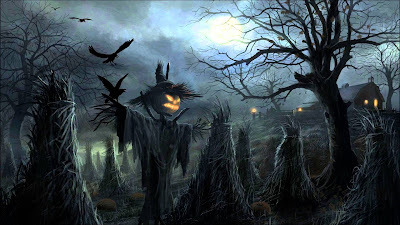
I was hoping to be able to tell you more interesting stuff this week, particularly with regard to the Heck series and my next crime novel and so forth, but despite the fact we’ve slipped quietly into the autumn, we are in many ways still deep in the holiday season, and information in my industry isn’t travelling back and forth quite the way it would in normal times.
So, yet again, I’m going to have to put any announcements on hold, and instead, we’ll be focussing on the fact that it is now autumn by going a little GHOSTLY …
Yes, despite all appearances, September is with us, and the waning of the year has officially commenced. Okay, there are only the merest hints of red out there in the woodland brocade thus far, the sun is high and the air temperatures warm. But the fruit is hanging full and lush, the nights are drawing in and the mornings are starting out misty.
In anticipation of the real darkness shortly to come, not to mention the fog and the cold and the twisting, leafless branches, this seems like the ideal opportunity to launch an occasional new feature, which I’ve been toying with for quite some time.
Welcome to …
TRIO OF TERROR
It struck me recently, while combing my way through the world of dark and eerie fiction, that, while it’s a lot of fun and very rewarding to be reviewing novels and collections or anthologies of short stories, one form of fiction I’m not offering my thoughts on is the short novel or novella.
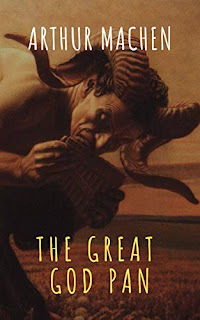 Now, this was a bit of a shock given that I’ve written quite a few of these and at one time had a reasonable rep for them. My own novella,
Kid
, won the British Fantasy Award in 2007, and two more,
Sparrowhawk
and
The Tatterfoal
, were both short-listed for the same award in 2010. And it’s not as if I haven’t read and enjoyed novellas by others.
Vardoger
by Stephen Volk (2009) is one of the finest I’ve ever read, closely followed by
White
by Tim Lebbon (1999). At the same time, who could forget such classics of their kind as Arthur Machen’s
The Great God Pan
(1894) and HP Lovecraft’s
At the Mountains of Madness
(1931).
Now, this was a bit of a shock given that I’ve written quite a few of these and at one time had a reasonable rep for them. My own novella,
Kid
, won the British Fantasy Award in 2007, and two more,
Sparrowhawk
and
The Tatterfoal
, were both short-listed for the same award in 2010. And it’s not as if I haven’t read and enjoyed novellas by others.
Vardoger
by Stephen Volk (2009) is one of the finest I’ve ever read, closely followed by
White
by Tim Lebbon (1999). At the same time, who could forget such classics of their kind as Arthur Machen’s
The Great God Pan
(1894) and HP Lovecraft’s
At the Mountains of Madness
(1931). So, hell, I thought, I ought to start reviewing novellas (and short novels) as well. I owe it to the authors and to anyone else who, by some remote chance, might be following my tips on here.
Thus, without further ado, here’s the new feature, and here’s the way it’ll work. Unlike an anthology or a full-blown novel, the average novella – most clock in at around 20K to 50K words – is too slim an object to my mind to merit a full Thrillers, Chillers entry all of its own. So, what I thought I’d do is review each one as they came along, but then store said write-ups in the back room until I had three I loved that sat together neatly, and then put the whole trio on the blog.
I stress that I won’t be doing a compare-and-contrast between the three; they’ll all be individual entities, written by different authors and may even have been written years and years apart. But it’ll be an interesting exercise to review three each time that perhaps complement each other either by tone, undercurrent or subtext. This week, for example, I’ll be reviewing Dolly by Susan Hill, The Devil’s Own Work by Alan Judd, and Dark Harvest by Norman Partridge … yes, you’ve guessed it, the common theme here today is ‘the darkness within ourselves’.
This will also assist at the end of each review, when I discuss a potential (i.e. imaginary) three-episode TV series, because you can’t have three episodes of something like that, which are wildly different from each other; theme must be maintained.
As usual, I’ll endeavour to keep the SPOILERS to a minimum; there will certainly be no given-away denouements or exposed twists-in-the-tail, but by the definition of the word ‘review’, I’m going to be talking about these novellas in more than just thumbnail detail, extolling the aspects that I particularly enjoyed (in each case, I’ll outline the plot first and follow it with my opinions) … so I guess if you’d rather not know anything at all about these pieces of work in advance of reading them yourself, then these particular posts will not be your thing.
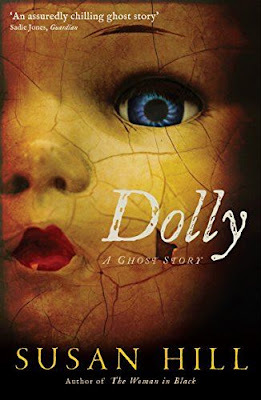 DOLLY by Susan Hill (2013)
DOLLY by Susan Hill (2013) Outline
We’re in England in the post-war era, and we open as two children, each in their own way lost, are relocated together at remote Iyott House. They are cousins but they barely know each other, and they couldn’t be more different in temperament.
Edward Cayley is an orphan who has been raised by his business-like stepbrother, not exactly cruelly but with no expectation of warmth or generosity, so he remains a quiet, observant boy who shows little in the way of emotion. Leonora van Horst, on the other hand, is the daughter of a flighty single mother, who travels the world in pursuit of wealthy men, and has never yet found happiness. Leonora is subsequently a spoiled, haughty child, who, while not unintelligent, has willfully turned a blind eye to her parent’s uselessness.
Edward and Leonora are not natural friends, and their new residence is hardly likely to make them so. It’s a dreary, damp abode far out in the Cambridgeshire fens, though their new guardian, their elderly Aunt Kestrel Dickinson, while unused to children, is inclined towards kindness and attempts to make them welcome, even if she has no option but to install their bedrooms in the attic.
As a wet, misty spring gives way to a hot summer, the eeriness of the children’s new home recedes, and their relationship develops. Edward still finds it difficult to get on with the ever-superior Leonora, but gradually her façade crumbles and she reveals much about her early life, pointing out the deficiencies of her mother, who is too self-centred to ever understand her daughter’s needs and desires, and failed always to buy her the one thing she really wanted: a beautiful doll dressed as an exotic princess.
When Edward confides this in Aunt Kestrel, she makes a wearying expedition to London to try and find such an item for Leonora’s birthday, finally returning with a delicate China doll, which though expensive and gorgeous is not the one Leonora wanted. In the most horrific display of ingratitude, the girl has a spectacular tantrum and hurls the doll at the wall, breaking it, before storming off, thereby setting in motion a series of supernatural events that will not just follow the two children into adulthood but will blight both their lives to the point of ruin …
Review
The first thing to say about Dolly is that we are firmly in Susan Hill territory. You won’t need to be a student of the genre to be aware that her most famous work to date is The Woman in Black , which is set at bleak Eel Marsh House on the northeast coast. Well, here we are further south in East Anglia, but it’s a flat, equally dreary landscape, and while the house has a different name, Yyott, the nearby village is called Eeyle.
So, straight from the beginning with Dolly , you know what you’re going to get.
Realistic, non-melodramatic characters compete for our attention against a grim backdrop of Gothic landscapes and supernatural spite that quite literally knows no end and which, at times, is genuinely so chilling that you may well be looking over your shoulder while you read.
Yes, there’s something about Susan Hill’s work that touches a very raw nerve.
So many ghost stories fall flat in the modern age, when society is seemingly beset by such a profusion of worrying issues that we find it difficult to fear the dead. But not in The Woman in Black , as many will attest, and definitely not in Dolly .
In addition, the manner of the evil that confronts us here is very unexpected. We’re not talking revenants, or rotted corpses rising, or shadow-figures rattling chains. But, without giving anything away, what happens in Dolly would still be mind-bendingly terrifying were it to happen to someone in real life.
So, don’t be fooled into thinking this is some quaint tale from the ‘ancestor that returned’ stable. It really, really isn’t. The horror here is real and visceral, and literally goes bone-deep.
On top of that, it’s all wonderfully written. Yet again, Susan Hill calls on her inner poet, perfectly and succinctly capturing the flat wilderness that is the East Anglian mudflats, the silent, winding waterways, the empty skies, the occasional rotting hulk of an abandoned farmhouse.
Read it, even if you’re not a ghost story aficionado. This is a mystery chiller of the first order, which will keep you awake and thinking about it long after you’ve turned the final page. But it’s also a wonderful piece of writing that grips, moves and entertains, and yet doesn’t waste a single word during its very manageable 160 pages.
 THE DEVIL’S OWN WORK
by Alan Judd (1991)
THE DEVIL’S OWN WORK
by Alan Judd (1991)
Outline
Two university friends embark on very different careers when they finish their education. One of them, an unnamed chap who becomes a schoolteacher, is deeply interested in literary fiction but has no talent himself and faces a future on the fringes of the intelligentsia, though, as a contented suburbanite, he isn’t daunted by this, especially when his French sweetheart, Chantal, accepts his proposal and the two of them settle down to what looks like a quiet middle-class life.
In contrast, the other one, Edward (surname never given), is a talented but inexperienced novelist, whose charm and good looks have opened doors for him before he’s even published his first book, and whose family’s wealth has allowed him to work as a literary reviewer while attempting to make his name as an author. Ironically though, it is one of Edward’s reviews that finally draws the world’s attention to him.
When he brutally criticises the latest novel by much-lauded writer, O.M. Tyrell, accusing the widely respected ‘doyen of English letters’ of favouring excessive style over anything approaching substance, the literati are stunned. Tyrell, though an octogenarian now and famously reclusive, is regarded as a genius whose work has for decades been beyond reproach. However Tyrell responds, which in itself is remarkable, by inviting Edward to interview him at his retreat on Cap Ferrat on the French Riviera.
At the same time, the teacher and Chantal will also be in southern France, visiting in-laws, and so a plan is made that all three will meet up after the interview and enjoy a brief holiday together. The teacher and Chantal arrive a day early, and see Tyrell in a harbourside café with his mistress Eudoxie, an exotic, ageless beauty who appears to wait on her very elderly beau hand and foot. That night, Edward attends Tyrell’s house as intended, but towards the end of the two writers’ friendly enough discussion, the older man dies from what seems to be a sudden heart attack. Before he expires, he hands Edward a bulky, handwritten manuscript, which at first glance is almost illegible, saying that this is for him … that it was ‘meant for him’.
Back in England, the teacher gets a brief look at the mysterious manuscript but considers it gibberish and dismisses it as an antique curiosity. However, from this point on, Edward’s career as a novelist soars. He pours out one prize-winning tome after another, earning a fortune in the process, though the teacher increasingly dislikes his best friend’s new books, thinking them well-written but uncharacteristically shallow. He is most startled, however, when, as old acquaintances, they hook up again years later and he learns that Edward, a distracted and oddly indolent fellow these days, has not only adopted Tyrell’s mantle as England’s most revered author, but is living with Tyrell’s former partner, Eudoxie, who, while the rest of the group are progressing into middle age, looks no older than she did before …
Review
Alan Judd is a very respected novelist in his own right, but The Devil’s Own Work attracted particular interest when it was published because it was the first time (and, to date, the only time) in which his subject was the supernatural. Perhaps inevitably, given Judd’s literary reputation, but also because of his biography of Ford Maddox Ford (which was published one year earlier) and a brief essay at the end of The Devil’s Own Work , in which he reveals that Tyrell was based on Graham Greene, readers and reviewers have looked for much deeper meanings in the work.
It’s certainly the case that in The Devil’s Own Work , Judd is revisiting Faust (for the uninitiated, a 16th century German astrologer who reputedly sold his soul to Satan in exchange for a long and successful life, a concept that has been rebooted many times in fiction), but Judd also uses this short but eerie novella to take potshots at a number of contemporary targets.
It’s a clear excoriation of literary critics, not just those who can’t write themselves, but those who follow fashion, jump on bandwagons and subsequently lose all objectivity. It’s also an expression of frustration at the handful of writers who achieve incredible fame when their work hasn’t merited it but were simply in the right place at the right time. It’s that bandwagon thing again, I suppose, the random mob mentality that condemns some to obscurity and others to fortune and glory. All of this is embodied in the affable but bland personality of the narrator in The Devil’s Own Work . He’s an unremarkable everyman who blends into the background when superstars take the stage. He’s resigned to a future of anonymity, but deep inside he becomes terser the higher his friend’s star rises, especially as he considers the adulation to be fake because the work is ultimately poor.
And this perhaps was Judd’s real purpose in writing The Devil’s Own Work : as a shot across the bows of literary elitists everywhere who are resting on their laurels, or simply undeserving of the praise, or who have set aside their own voice for the sake of commercial success.
Which is all well and good, but is this short work also effective as a horror story, because that is how it is packaged? And the answer, for me at least, is yes.
The Devil’s Own Work is written in linear fashion, the narrator taking us through the events of all the main characters’ lives (those he is aware of!) in a more or less straight line from the early days of hope and ambition right through to the final disaster, without making many deviations en route. He takes time out here and there to offer nuanced thoughts and views and his understanding of how the literary world works in particular, but it’s all so smoothly and precisely written that you can’t help but enjoy every minute. And yet, while all this is going on, the evil in the midst of the tale subtly but inexorably tightens its grip.
Not just on Edward, but on all three of our main protagonists.
It won’t surprise anyone and it won’t spoil anything to mention that the splendidly-named Eudoxie is part of the demonic entity invoked here, while the mysterious manuscript (think something incomprehensible along the lines of the Voynich Manuscript ) is the infernal source of Edward’s new ‘talent’. Early on, for the most part, it’s merely creepy, but the real jeopardy gradually emerges from the cursed writer’s ever more frantic efforts to free himself, and the terror that grows on him while his teacher friend observes coolly from what he assumes is a safe distance (‘envy’ as much a deadly sin as ‘greed’), the whole thing finally culminating in a finale which, while it isn’t exactly explosive, I personally found bone-chilling.
Alan Judd’s The Devil’s Own Work is the epitome of a literary horror story and hugely effective on many levels. And if you’re only here to be scared, don’t worry. That is one of them.
 DARK HARVEST
by Norman Partridge (2006)
DARK HARVEST
by Norman Partridge (2006)
Outline
It’s 1963, and we’re in a nameless Midwest town, which is famous for one thing only: rearing high-grade corn. The quality of the produce is no surprise for two main reasons. One, the cornfields stretch to virtually every horizon. Two, the town lives under an ancient spell, which, depending on the events of each Halloween Night, may leave it in financial ruin, or grant it the huge boon of agricultural success.
However, the latter is not easily obtained. For reasons a tad obscure (again, we’re looking at some kind of supernatural pact or curse), each October 31st, a nightmarish figure arises from the pumpkin patch at the end of the black road. It’s known by a variety of names – Hacksaw Face or Sawtooth Jack, or more commonly, the Halloween Boy. It takes the form of a suit of raggedy old clothes, now filled with vegetable matter (and candy!), with an oversized pumpkin for a head, on which a truly evil face has been carved.
Every year it’s the same story, the monstrosity slowly taking shape on a cruciform structure left out there just for this purpose, and finally, on Halloween Night, released, armed with a butcher’s knife and sent on foot into the town, where it will annihilate anyone it encounters, though ultimately, it has a more specific intention: to get to the old brick church at the heart of the curse before the automated bell system sounds the midnight hour. If it succeeds in this, the town is doomed – at least for another year, though the consensus is that it wouldn’t survive even a few months under such hardship.
To give the townsfolk a fighting chance, they are permitted to try and stop the monster, but this task may only be accomplished by a male aged between 16 and 18. Thus, every Halloween Night, in an event called simply ‘the Run’, while everybody else hides, the young guys in the town are out en masse, armed with baseball bats, pipes, axes, knives and pitchforks. Their purpose is to destroy the Halloween Boy before he gets anywhere near achieving his goal.
Inevitably, there’s an air of total lawlessness. The all-male teenage gangs have been starved for the previous five days, the idea that they’ll go after the creature all the more hungrily because of the chocolates and other goodies where his heart should be, but also, I suspect, so that none of them will be completely on their game. For both these reasons, there is much looting and Purge-type violence between the rival groups. In response, the town’s sole cop, Jerry Ricks, a hick of the first order, patrols with a vengeance, and thinks nothing of shooting first and asking questions later.
No matter how many people die on October 31st in this place, questions never seem to be asked. But Ricks isn’t just the way he is because he likes hurting people (even though he does). He’s also the paid-up attack-dog for the Harvesters’ Association, the shady controlling-power in this neck of the woods, who stand to gain the most whenever the Halloween Boy is beaten, and therefore are probably at the root (no pun intended) of this mysterious situation.
This makes the all-licensed Ricks a very dangerous individual indeed. Almost as bad as the monster at the heart of the tale. Maybe worse.
Meanwhile, all these dangers aside, the prize for the guy who finally takes the target down is felt to be worth the risk. His family is showered with financial benefits, a new house, a new car and the like. But he – the kid who did it – gets to leave. Because that is the other thing. No one else ever escapes this one-horse town. They literally can’t. It’s an out-of-time capsule, a mini-universe wherein the Halloween horror story repeats itself year after year, until it’s now become a self-fulfilling prophecy of blood.
This year though, it might be different, because a loner, Pete McCormick, the son of the town drunk, and a kid in awe of Jim Shepherd, who won the prize the previous year and has since vanished, is determined to find out what lies at the heart of this darkness. He is assisted in this by one Kelly Haines, a girl, so she shouldn’t even be on the streets, but someone else who’s been abused by the town’s authorities and is now determined to get answers (and payback).
It is no small thing for these two isolated youngsters, who have never seen beyond the endless flatlands of corn, to confront and defeat the monstrous Halloween Boy, and at the same time evade the ever-watchful eyes of Jerry Ricks and the Harvesters’ Association …
Review
I first approached Dark Harvest thinking we were in the realms of an archetypal stalk-and-slash romp. It had all the makings. An undead maniac with scarecrow attributes and edged steel in his fist. A Palookaville town cut off by geography and culture from the rest of the modern world. Teens in jock jackets riding hot rods while armed with bats. A redneck cop who lets his nightstick do all the talking. And of course, lashings and lashings of Halloween.
It was all there. All I had to do was sit back and enjoy the procession of ever-more brutal murders. But that’s not how it played out.
Quite rightly, Dark Harvest won the Bram Stoker Award in 2006 and was named one of the Best 100 Books of the Year by Publisher’s Weekly . You don’t need to be a horror aficionado to know that wouldn’t happen with everyday slasher fare.
First of all, the style of the writing is Norman Partridge at his concise but visual best. It’s got energy, it’s got drive, rattling us at speed through one nerve-tingling situation after another, but always hitting us with rich if macabre poetry. So yes, there are incredibly gory deaths and some smash-bang action sequences, but the unique atmosphere of Halloween – ‘the smell of cinnamon, gunpowder and melted wax’ – emanates from the pages.
At the same time, there’s a genuinely warm heart under all this carnage.
The monster is not an unthinking killing-machine, the evil is nothing to do with the scariest night of the year, or a witch’s curse, or any kind of devil or demon. I don’t want to say too much more here, because I don’t want to give away any serious spoilers, but suffice to say that, as our two heroes dig deeper and deeper into the complex mystery (because this is not just another night when half-crazed individuals run a gauntlet of ultra-violence), they uncover very human reasons for the perversion of this once homely community.
It might seem ridiculous at first glance, this annual nightmare that visits a town in the middle of nowhere, but ultimately you’ll recognise a familiar story here: a few bad apples souring things for everyone else; human self-interest running without restraint, leading in the end to complete societal breakdown. There is definitely a meaning to all this madness.
The other thing that really caught my eye about Dark Harvest is that we’re not in a world of stereotypes. Again, from the cover blurb, you might be tempted to think it’s good guys, bad guys and a monster. But no, it isn’t that simple. Even the monster has a multi-levelled personality and evokes much pathos, while the heroes, Pete McCormick and Kelly Haines, could easily fall into the ‘Loser Club’ bracket where so many ‘small town horror’ outcasts have dwelled in the past. But they don’t. They’re just ordinary teenagers, with the same strengths and weaknesses that we all share. Even the villains have a purpose in Dark Harvest ; they’re not just evil for the sake of it. I particularly liked Mitch Crenshaw in this regard, the coolest kid in town and the candidate most likely to take the Halloween Boy down this year, as he’s on it's trail in his souped-up Chrysler. A slick badass, tunnel-visioned, violent tempered and seemingly dismissive of his doofus buddies, and yet, when they’re in real danger, he shows concern for them.
Again, I’ve probably said too much about Dark Harvest . The idea of this is to sell it, not tell it. So go and check it out. It’s justifiably earned its reputation as one of the best Halloween-flavoured horror novellas on the market. It’s a wild ride for sure, but there are very deep tracts here that will satisfy you far, far more than the average ‘pitchfork and hatchet’ job.
And now …
Trio of Terror 1 – the TV show
Though of course, that title won’t do. So, with regard to this occasional feature, I’m even going to be impudent enough to give it a title. How about, on this occasion, The Monsters Inside.
Check out these possible casts (all for fun, of course – which is why I have an unlimited budget)
Dolly
Edward – Alex Pettyfer
Leonora – Emilia Clarke
Aunt Kestrel – Judi Dench
The Devil’s Own Work
Edward – Aaron Taylor-Johnson
The Teacher – Will Poulter
Eudoxie – Cara Gee
Tyrrel – Anthony Hopkins
Dark Harvest
(Out of my hands, this one, as a movie’s just been made and is very shortly for release. So, this is an actual cast):
Richie Shepherd (standing in for Pete McCormick) – Casey Likes
Kelly Hines - E’myri Crutchfield
Jerry Ricks – Luke Kirby
Published on September 02, 2022 08:34
August 11, 2022
When swords were mightier than words

This week (as loosely promised last week), I’ve got a big announcement to make. But first, once again, I must apologise for the tardiness of recent posts. Lots of readers have been sending me messages to ask me stuff, and I haven’t been able to tell them anything solid, mostly because of circumstances beyond my control, but at last the dam is starting to break.To begin with, I can today tell the world about a new contract I’ve signed to write a whole new series of books for Canelo. It’s a very different venture, this one, and a radical new direction for me!
So new in fact – in professional terms, that is – that once I embark on it, you might call me a stranger in a strange land. And entirely by coincidence (honest!), that happens to be the name of the book I’ll be reviewing today, Robert Heinlein’s astonishing work of high concept science-fiction, STRANGER IN A STRANGE LAND.
I’m aware that was rather a weak link, by the way, but suffice to say that SIASL was Heinlein’s masterwork, a true futuristic epic, and in my new venture, I’m also entering the world of the epic novel (though not the future, the past), so there is a kind of connection between the two.
As always, if you want to go straight to the book review, shoot on down to the Thrillers, Chillers section at the lower end of today’s post. But remember, there’s this other massive development to talk about first …
A new direction
It’s probably a secret to many readers of this blog, mainly because it deals primarily with ‘dark fiction’, but I have an abiding love of historical novels. And by that, I don’t mean historical romance or historical mystery. I mean historical action, preferably set around dramatic true events of the past. Epic adventures from the days when swords spoke louder than words.
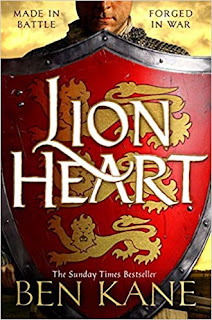 The novels of Ben Kane, Bernard Cornwell, David Gilman, Conn Iggulden, Matthew Harffy, Christian Cameron, Angus Donald and many others, fill my shelves. What’s more, my interest covers a huge spectrum, from the Ancient World right up to our most recent international conflicts.
The novels of Ben Kane, Bernard Cornwell, David Gilman, Conn Iggulden, Matthew Harffy, Christian Cameron, Angus Donald and many others, fill my shelves. What’s more, my interest covers a huge spectrum, from the Ancient World right up to our most recent international conflicts. It’s not just out-and-out military stuff, though.
I’m equally fascinated by the intrigues of kings and their courtiers, the madness of emperors, the heroism of knights, the untamed spirit of the Vikings … all of these writers I’ve named specialise in these fields, and I’ve long yearned to have a crack at this exhilarating stuff myself. So, in the end, I did.
Throughout the pandemic, I was busy writing on spec. A load of new stuff has poured out of my keyboard, including a big historical actioner called WOLFHEAD, which is set in England at the cross-over point between the Dark Ages and the Middle Ages.
 It follows the adventures of Cerdic of Wulfbury, a young English earl who loses everything during the blood-drenched fury of Harald Hardraada’s invasion of Northumbria in 1066, but who’s determined to win it all back despite the chaos and brutality of the ensuing Norman Conquest.
It follows the adventures of Cerdic of Wulfbury, a young English earl who loses everything during the blood-drenched fury of Harald Hardraada’s invasion of Northumbria in 1066, but who’s determined to win it all back despite the chaos and brutality of the ensuing Norman Conquest.I’m now proud to announce that the book has been bought by Canelo, who’ll be bringing it out in paperback and ebook, as written by ‘PW Finch’, next April.
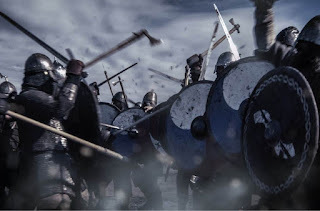 They’ve also, and this is the really cool bit, commissioned a further two novels from me, not exactly follow-ups but also set in the early medieval period, and occurring tumultuous but true historical events.
They’ve also, and this is the really cool bit, commissioned a further two novels from me, not exactly follow-ups but also set in the early medieval period, and occurring tumultuous but true historical events. I consider this an unbelievably exciting development in my career, but one minor question remains: whether or not I should include news and updates about this new line of novels on this blog?
WALKING IN THE DARK is primarily concerned with dark fiction, and a lot of my historical writing will be very dark indeed, but it won’t be Dark Fiction per se. So, do I include it on here simply because it’s written by me, or do I start an entirely new blog dedicated to the ages of swords and chivalry?
At present, I genuinely don’t know (so all answers will be given grateful consideration).
Heck
And now onto something radically different. My bread and butter, you might say. The book series that first got me into mass-market publication.
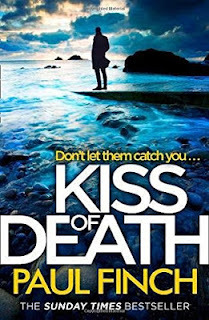 The DS Mark ‘Heck’ Heckenburg novels have been by far my most successful book series to date, and back in 2018, with
KISS OF DEATH
, I left them on something of a cliff-hanger. The intention was always to write and publish a follow-up very quickly, but many things have got in the way, not least Covid, on/off lockdowns, a change of publisher, a new deal to write standalone crime thrillers for Orion, etc. However, while Heck has been nowhere near the bookshelves of late, he’s never been far from my thoughts.
The DS Mark ‘Heck’ Heckenburg novels have been by far my most successful book series to date, and back in 2018, with
KISS OF DEATH
, I left them on something of a cliff-hanger. The intention was always to write and publish a follow-up very quickly, but many things have got in the way, not least Covid, on/off lockdowns, a change of publisher, a new deal to write standalone crime thrillers for Orion, etc. However, while Heck has been nowhere near the bookshelves of late, he’s never been far from my thoughts. Or my laptop.
I’m happy to announce that the next Heck novel is already written. As I say, I managed to use lockdown to get well ahead on my actual writing, but finding a publication slot for it has proved complex. I’m very hopeful that now at last there are movements on this front too, and that we’ll be able to make an announcement on this as well, very soon in the near future.
All those to whom this comes as welcome news, keep checking in, because I’ll post result news as things progress.
THRILLERS, CHILLERS, SHOCKERS AND KILLERS …
An ongoing series of reviews of dark fiction (crime, thriller, horror and sci-fi) – both old and new – that I have recently read and enjoyed. I’ll endeavour to keep the SPOILERS to a minimum; there will certainly be no given-away denouements or exposed twists-in-the-tail, but by the definition of the word ‘review’, I’m going to be talking about these books in more than just thumbnail detail, extolling the aspects that I particularly enjoyed (I’ll outline the plot first, and follow it with my opinions) … so I guess if you’d rather not know anything at all about these pieces of work in advance of reading them yourself, then these particular posts will not be your thing.
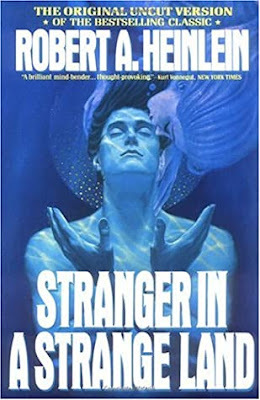 STRANGER IN A STRANGE LAND
by Robert Heinlein (1961)
STRANGER IN A STRANGE LAND
by Robert Heinlein (1961)
Outline
About a century into the future, the manned Earthship Envoy is lost while attempting to land on Mars and all communications from its handpicked crew cease. As World War III is just about to break out on Earth, no further missions to the Red Planet are possible for another 25 years, at the end of which the spacecraft Champion makes the same journey and this time lands successfully. The crew of the Champion, including the Arabic scholar and astronaut, ‘Stinky’ Mahmoud, make contact with the Martian race (who are fantastically indifferent to humanity), and are surprised to learn that a new-born child survived the crash of the Envoy, a child that has now grown to adulthood under the care and governance of the Martians.
For reasons uncertain to the crew of the Champion, the child-turned-man is ordered by his adopted parents to return to Earth with his own people, who name him Valentine Michael Smith.
He arrives on an Earth he doesn’t know, but which is also very different from the one that existed when his own parents set out on the first expedition. Individual countries are now demilitarised, having been replaced by a Federation of Free Nations, and there is a single World Government, which guarantees peace and stability. However, there is also a dark side to this new order. Organised religions now wield huge political power, the most sinister of them the massively influential Fosterite Church of the New Revelation, while the government itself is autocratic and, if necessary, can call on a force of highly trained and ultra ruthless troops, the Special Service, known somewhat appropriately as the SS.
Childlike and disoriented, the seemingly helpless Smith is at first incarcerated in the military medical facility, Bethesda Hospital, in Maryland. As he understands nothing about gender, because it doesn’t exist on Mars, Smith is treated only by male staff. But an independent-minded nurse, Jill Boardman, considers this a challenge and when she tricks her way into his private apartment, shares a glass of water with him, unaware at the time that this makes her his ‘water brother’, a deep and important relationship on Mars where water is a rare but crucial resource.
Strangely affected by the meeting with Smith, Jill later describes it to her on/off boyfriend, Ben Caxton, an investigative journalist, who advises her that, as sole heir to the crew of the Envoy, Smith is already extraordinarily rich, but thanks to some legal precedents set during Earth’s colonisation of the Moon, he might also be the lawful owner of Mars, which would not just make him the wealthiest man in the world by some margin, it would put him at the centre of a political storm of epic proportions, which could likely endanger his life. Jill is worried enough by this to bug Smith’s hospital room, while Caxton writes news stories designed to embarrass the World Government into releasing the captive.
However, Caxton is arrested by the SS, and in a panic, Jill attempts to smuggle Smith out of the hospital. When the SS catch up with her too, Smith, with a curious sleight of hand, makes them all disappear. Jill is horrified to have witnessed what she assumes is mass murder, which in its turn sends Smith into a self-induced catatonic trance. With no other option, Jill takes Smith to Pennsylvania and the rural retreat of Jubal Harshaw, an old friend of Caxton’s and a retired physician and lawyer, who now makes his living as a writer and is regarded as one of the foremost thinkers of the age.
While staying at Harshaw’s pleasant but chaotic enclave, which he shares with various tough handymen and a trio of beautiful, super-intelligent secretaries, Anne, Miriam and Dorcas, Smith becomes more attuned to the patterns of life on Earth, and demonstrates genius-level intelligence and advanced telekinetic powers, all of which fascinate Harshaw but alarm him as well. In return, Smith is particularly intrigued by the human concepts of religion and God. Neither exist in the minds of Martians, but they are not impossible for him to understand as, on Mars, the afterlife is populated by the Old Ones, the souls of Martians who have died, or ‘discorporated’ as he refers to it, and who then adopt deity-like status. To Smith, the term ‘to grok’ means to be completely familiar with something in a deep and profound way, and so to him, God is ‘one who groks all things’, which means that God is all things. This leads him to coin the phrase whenever greeting friends, ‘thou art God,’ though he remains oblivious to the possibility that this may be misunderstood in a world where religious fanatics exert strenuous authority.
While Smith familiarises himself with (and becomes an expert in) all things human, and slowly but surely wins the hearts of Jill, Anne, Miriam and Dorcas, Harshaw fends off an assault by an SS snatch squad by contacting Joseph Douglas, Secretary General of the Federation of Free States, in the process managing to secure the release of Ben Caxton and establish that Smith is not the heir-apparent to Mars itself, making him politically unimportant and therefore much safer. As a final protective measure, Harshaw persuades Douglas to make himself the hugely wealthy Man from Mars’s official business advisor, a very lucrative position, which will render Smith all but untouchable.
Now a VIP, Smith is celebrated worldwide, and even invited to visit the Fosterite Church of the New Revelation, the appeal of which is easy to see given that it encourages sex, drunkenness and gambling so long as they all occur on church premises and any money spent goes to the church itself. Despite the Fosterites’ obvious hypocrisy (their temples are more like casinos or brothels than places of worship), no one ever challenges them because bribery of politicians and policemen, and violence against dissenters, are also within church policy.
Unimpressed by this farrago, Smith, now with Jill as his adoring acolyte, goes on the road, performing tricks in a carnival, where he meets tattooed snake-handler and Fosterite loyalist, Patty Paiwonski (who after a steamy night of sex, also becomes his disciple), and visiting ‘girlie’ shows in which he convinces Jill to participate so that he might try and fathom the mystery of human lust. But none of this satisfies Smith as he looks for a way to make Martian sense of the strange world that is Earth. Eventually, still enthralled by the concepts of religion and faith, he uses his limitless wealth to create the Church of All Worlds, with himself, now much deluded about his own status, as the guru and messiah at its heart.
This new religion borrows heavily from the Fosterite cult, particularly the freedom to sexually experiment, but it is not interested in making money and proves hugely attractive to the masses because Smith calls on his psychic abilities to perform what appear to be real-life miracles. In due course all those he has met, including Miriam, Dorcas, Anne and even Ben Caxton, have been drawn in and become followers.
Only the arch-cynic Jubal Harshaw keeps one eye on the monolithic Fosterite power from which adherents are now defecting en masse, and worries that established leaders rarely appreciate it when newcomers chip away at their base …
Review
It seems to me that fiction is filled with Christ allegories. What’s more, they range widely, from CS Lewis’s The Lion, the Witch and the Wardrobe to Ken Kesey’s One Flew Over the Cuckoo’s Nest (to name two very obvious examples), and from The Wachowski Brothers’ The Matrix to The Who’s rock opera, Tommy (to name two that are less so). But I doubt there’ve been any that are quite as in your face as Robert Heinlein’s philosophical sci-fi masterwork, Stranger in a Strange Land .
And yet, it isn’t a straightforward analogy.
You might consider that Heinlein, who by the norms of speculative authordom at the time was considered to be culturally and politically conservative, would be the obvious one to preach the Jesus story through the prism of science fiction. And at first glance, it looks as if he did just that, with Valentine Michael Smith the miracle-working prophet, Earth the desert in which he comes to realise his purpose, the SS the Romans, the Fosterite Chuch the Sanhedrin and Jubal Harshaw the Judas-like face of mankind, who later yearns to believe that he was in touch with the divine but will always be tortured by doubt.
So yes, when Robert Heinlein first penned his 220,000-word epic, it genuinely must have looked to many as if he was giving us a blow-by-blow re-run of the New Testament .
But as I say, there are problems with this thesis.
First of all, the society that Smith eventually creates is as unAmerican as you could have imagined at the time of the book’s publication, promoting communal living, nudism, free love and shared ownership of everything. It would certainly interest and influence the hippie movement (and indeed it did, including the Manson sect!), but the hippies weren’t around in 1961. What Heinlein was espousing was at the time a very revolutionary creed, so much so that if it had been allowed to, it would undoubtedly have caused offence to the real-life religious authorities of the era. It might even have been deemed sacrilegious and, despite it winning the Hugo Award and taking sci-fi for the first time ever into the New York Times best-seller lists, it was cut by 60,000 words before hitting the high street bookshops, and even then was quickly removed from schools, colleges and libraries.
Heinlein’s response to this was, first of all, that Stranger in a Strange Land had never been intended as a religious text, but that the idea had sprung originally from The Jungle Book , and secondly, that he wasn’t in the business of teaching anyone anything, but was simply posing a hatful of new ideas, which his readers could judge for themselves. “It’s an invitation to think,” he famously said, “not believe”. At no stage, did he state that Valentine Michael’s Smith’s proposed Heaven on Earth was possible or even desirable.
And maybe there are hints of this in the actual narrative. For much of the book, Smith remains an innocent, trying to learn his way through the complications and absurdities of a society that he had no notion even existed before his 25th birthday. But he has latent psychic powers, vastly more than the average human, and as he gradually becomes aware, has no hesitation in using them. Making members of the SS ‘disappear’, in other words killing them, might seem forgivable. But they aren’t the only group he reserves this punishment for. In other cases, he doesn’t always go the whole hog, but simply makes his opponents’ clothing disappear in public. He also spends time as a carney, where he learns cheap tricks and gimmicks, and later on during his ministry, retains something of the same aura: namely that he is a conjuror putting on a show, the superficial wonders of which mask his empty message and power-seeking nature.
Other reviewers have wondered if this is a flaw in the writing. Myself, I consider it deliberate.
For example, while it’s true that Smith’s lack of interest in monetary gain would definitely have rung a bell with ascetic Christians everywhere, in Stranger in a Strange Land it only comes about because he’s already flush with inexhaustible amounts of cash. So, it’s hardly laudable. And while he identifies the Fosterite Church as a glaring case of evangelical phoniness, he borrows several of its most popular elements – the cathartic use of group-sex being one – as a means to boost his own operation. It might be relevant that Heinlein’s original title for this novel was The Heretic .
For all these reasons, though Stranger in a Strange Land is regarded widely as a sci-fi classic, it remains divisive even now, 60 years after first publication. But that’s its strength. There is so much in this book to discuss that it cannot fail to stimulate lively minds.
It’s not perfect, though.
It was the unabridged version I read, which at 220,000 words is simply too long and drawn out, but I’ve heard similar said of the 160,000-word version. This is primarily because much of the run-time is occupied by philosophical discussion, usually when Jubal’s on the page, rather than actual action. Heinlein even had problems with this on publication. Puttnam, the book’s original publisher, considered that it was too much of a mammoth read for what it actually contained, and this also was given as a reason for the huge cuts the author was required to make.
In addition, and this is a point that could be made often about sci-fi writers of the golden age, while Heinlein’s cosmic vision was astonishing, there are many moments in the book that are clearly stuck in the 1950s. For example, his characters still smoke and drink lots of coffee. Crude slurs are used in reference to homosexuality (which otherwise barely rears its head), while the banter between men and women is laden with innuendo.
In fact, it’s this latter aspect of Stranger in a Strange Land that is most glaringly at odds with the author’s concept of a future Earth, especially in his examination of possible routes to a happier society.
Looking back on our own era of sexual liberation, we can see that it was never intended to create an age of objectification (even though it did), but in this novel at least, Robert Heinlein sees no grey area between the two. So, for example, we go from relatively innocuous anachronisms like nurses still wearing stockings under their uniforms and doctors referring to them with saucy nicknames, to the slightly more serious, such as the moment in the story where Jill Boardman opines that most women who are raped have instigated it themselves.
But it’s the continued eroticisation of female characters in this book that seems to jar the most. Though Jill Boardman, a strong, intelligent woman, previously earned her living as a highly-qualified nurse, when she’s on the road with Smith he uncovers a secret exhibitionistic side to her nature and encourages her appearance in strip shows. And though this could be seen as part of her preparation for life as a priestess in Smith’s temple, as her main role then will be to have sex with the new devotees, that itself is surely a questionable destiny. But Heinlein goes even further than this, Smith later using his telekinetic powers to reshape the already-delectable Jill and other female acolytes into literal love goddesses.
Don’t get me wrong. I wasn’t offended by it, but I won’t pretend that I didn’t find all this a bit curious and at odds with the more thoughtful and introspective first half of the book.
Again though, could this have been Heinlein’s intention all along?
We’ve already discussed Valentine Michael Smith’s conman tendencies and when the mob finally descends on his Church of All Worlds, the sort of charges they level at him include running a prostitution racket and corruption of minors … even in the midst of the carnage is the author hitting us with some bitter truths about the glorious sin-free world we’ve been invited to imagine?
I suppose you just have to read it and draw your own conclusions. And despite it’s huge length, and despite what might sound like several reservations on my part, that won’t be a trial.
Heinlein focusses mostly on story and subtext(s), not bothering us with gluts of unnecessary scientific detail, though as usual he almost casually tosses in a variety of wonderful ideas. I especially liked the emergence of a strand of humanity who possess total recall, and who subsequently find employment not just as super-secretaries but as professional legal witnesses, while Smith’s Martian-taught ability to literally shut himself down, slip into voluntary catatonia so that he can take all the time he needs to work stuff out, is something I’ve never seen previously.
The novel is wordy by modern standards, but superbly written, as you’d expect – the author never puts a foot wrong technically – and peopled with characters so vivid that you can feel them in the room with you. Despite the widely ranging philosophy and deep and protracted investigations of human culture and society, it’s never over-heavy. The whole thing flows from the page, at no stage getting away from itself even though it runs to colossal length. But on top of that, there’s something mischievously joyful about it all. Heinlein might not have believed in the ‘free-money free-sex’ society he experiments with here, but he clearly liked the idea. And if he genuinely did, as some reviewers have suggested, set out to purposely slaughter all the sacred cows of 1950s America, he did it with a twinkle in his eye.
Ultimately, you’ve just got to read Stranger in a Strange Land . It’s so vast a project that no single review can cover every base in one go. And for this reason alone, it’s rightly earned its classic status. And if you don’t believe that, how many other sci-fi novels can you name that still cause heated arguments over half a century after publication and even went on to inspire the creation of a real-life religious movement (because the Church of All Worlds is now an actual thing)?
So, there you go. Don’t listen to me. Just read it, and as the late Robert Heinlein would have said, decide for yourself.
I’m not sure if it would ever be possible to do Stranger in a Strange Land justice on film or TV given how prevalent the sex and nudity, but I suppose the less-than-prudish 21st century would be the time to do it. It probably won’t happen, but in case anyone’s talking about it, here’s your cast, fellas:
Valentine Michael Smith – Brant Daugherty
Jill Boardman – Jennifer Lawrence
Ben Caxton – Cillian Murphy
Jubal Harshaw – Jon Voight
Dr ‘Stinky’ Mahmoud – Riz Ahmed
Patty Paiwonski – Rachael Harris
Joseph Douglas – JK Simmons
Anne – Emma Stone
Miriam – Zazie Beetz
Dorcas –Miranda Kerr
Published on August 11, 2022 03:32
August 1, 2022
Henges, barrows and malicious pixie folk
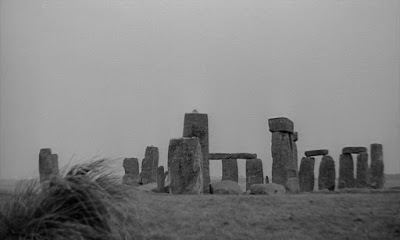
Humble apologies if I’ve been a less than conscientious poster this last few weeks. That’s not because I’ve been away on holiday. It’s simply that an awful lot has been going on behind the scenes here at Finch Towers, and yet at no stage have I actually been able to report anything solid. However, at last all this is finally changing.
I hoped to have quite a bit of interesting stuff to report today – mainly about my novel-writing, both current projects and future plans – but even if any such announcement on that front needs to go on hold for another week or so (I know, I know … frustrating!), at least I can talk freely about some major progress made on the latest installment of my TERROR TALES anthology series, which we’re looking to publish in the autumn and which will be TERROR TALES OF THE WEST COUNTRY, and I will certainly enjoy dropping a few fun hints about what it will contain.
In keeping with that last item, today’s book review also takes us into the West Country.
It’s the bone-chilling horror novel, CUNNING FOLK , by Adam Nevill. As usual, you’ll find that review at the lower end of today’s post, in the Thrillers, Chillers section. Scoot on down there straight away if you must, but let me remind you that I have other stuff to talk about first.
Mystical England
I’m now in the process of line-editing the stories I’ve compiled for TERROR TALES OF THE WEST COUNTRY, and it’s proving to be an absolute joy.
The West Country lies at the very heart of mystical England, the spiritual home of what we these days called ‘folk horror’.
 Its pastoral landscape is planted thick with rural legends and studded with the relics of ancient civilisations now entirely vanished from history. Avebury, Stonehenge, Silsbury (right) and other time-worn monuments attract thousands of tourists each year, but remain steeped in bewildering mystery. The lore of this place is equally venerable. According to myth, this is the Summer Land, and entrances to the faerie realm still lurk behind the tranquil facades of woodland pools, at the backs of caves or in the gnarled faces of age-old trees. King Arthur, they say, ruled this land from Cadbury Castle, the original Camelot, while Jesus himself walked amid the limestone ridges of the Mendip Hills, his uncle, Joseph of Arimathea, later planting the Glastonbury Thorn and watering it from the Holy Grail.
Its pastoral landscape is planted thick with rural legends and studded with the relics of ancient civilisations now entirely vanished from history. Avebury, Stonehenge, Silsbury (right) and other time-worn monuments attract thousands of tourists each year, but remain steeped in bewildering mystery. The lore of this place is equally venerable. According to myth, this is the Summer Land, and entrances to the faerie realm still lurk behind the tranquil facades of woodland pools, at the backs of caves or in the gnarled faces of age-old trees. King Arthur, they say, ruled this land from Cadbury Castle, the original Camelot, while Jesus himself walked amid the limestone ridges of the Mendip Hills, his uncle, Joseph of Arimathea, later planting the Glastonbury Thorn and watering it from the Holy Grail. But there are terror tales here too.
In The Hound of the Baskervilles , Conan Doyle was only mining a long-standing Devonshire tradition that phantom hounds roamed the wilds of Dartmoor, while mysterious hill figures hint at the one-time presence of pagan gods and warlike giants.
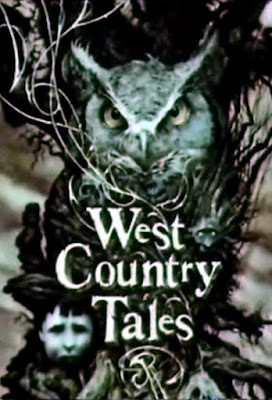 So rich is this region in eerie superstition that it remains the only part of the British Isles to spawn its own supernatural drama series,
West Country Tales
, screened on BBC2 in the early 1980s.
So rich is this region in eerie superstition that it remains the only part of the British Isles to spawn its own supernatural drama series,
West Country Tales
, screened on BBC2 in the early 1980s. From the outset, I considered it vital that all the stories I accepted hit this spot precisely, and I had to advise all potential authors of that in the firmest possible terms.
in the end, they haven’t disappointed, and yet we’ve got an astonishing range of material. Everything from the demonic being who stalked the people of Devon to the Somerset farmer driven to physical ruin after trespassing at the pixie fair, from the many-limbed beast lurking among the shoreline rocks to the murderers who tore each other to pieces in the presence of their victim.
But I don’t want to say too much, obviously. The book isn’t due out until the autumn, and if you want to hear more, you’ll need to wait until then (though I will be posting a few more teasers in the weeks between then and now). But just for the fun of it, here’s a gallery of images related to some of the eeriness we’ll explore in this latest anthology.
 A circle of cute figurines on a nicely-laid table in a rather majestic coastal residence. But each time one of them gets broken, something truly terrible happens. One by one, a select group of very different people are meeting grisly fates ...
A circle of cute figurines on a nicely-laid table in a rather majestic coastal residence. But each time one of them gets broken, something truly terrible happens. One by one, a select group of very different people are meeting grisly fates ...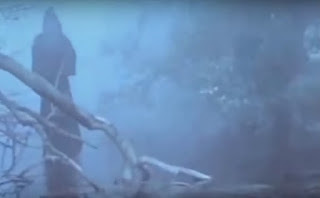 A scenic river flowing through a picturesque realm. Nowhere could be prettier, neither in summer nor winter. But people keep dying here, and rumours persist that something horrible prowls the scenic riverbank ...
A scenic river flowing through a picturesque realm. Nowhere could be prettier, neither in summer nor winter. But people keep dying here, and rumours persist that something horrible prowls the scenic riverbank ... A narrow defile in an arty part of town. But the blood that soaked the cobblestones here was very real indeed. So real that even today, the locals still avoid it after dark, while the tourists, who think it sounds amazing, tend to find the inky shadows lurking in its eerie recesses just a little bit too much if they go there alone ...
A narrow defile in an arty part of town. But the blood that soaked the cobblestones here was very real indeed. So real that even today, the locals still avoid it after dark, while the tourists, who think it sounds amazing, tend to find the inky shadows lurking in its eerie recesses just a little bit too much if they go there alone ... People don’t just avoid these woods because of their otherworldly appearance, it’s because of the terrifying predators that supposedly live here, one of them in particular with a reputation for having ripped out throats well into modern times ...
People don’t just avoid these woods because of their otherworldly appearance, it’s because of the terrifying predators that supposedly live here, one of them in particular with a reputation for having ripped out throats well into modern times ...THRILLERS, CHILLERS, SHOCKERS AND KILLERS …
An ongoing series of reviews of dark fiction (crime, thriller, horror and sci-fi) – both old and new – that I have recently read and enjoyed. I’ll endeavour to keep the SPOILERS to a minimum; there will certainly be no given-away denouements or exposed twists-in-the-tail, but by the definition of the word ‘review’, I’m going to be talking about these books in more than just thumbnail detail, extolling the aspects that I particularly enjoyed (I’ll outline the plot first, and follow it with my opinions) … so I guess if you’d rather not know anything at all about these pieces of work in advance of reading them yourself, then these particular posts will not be your thing.
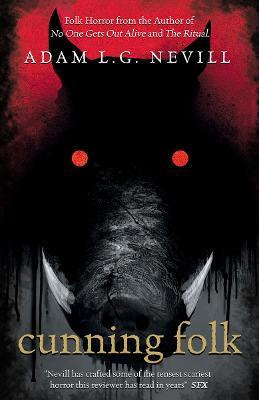 CUNNING FOLK
by Adam LG Nevill (2021)
CUNNING FOLK
by Adam LG Nevill (2021)
Outline
No home is heaven with hell next door …
That’s the perfectly apposite tag-line for this tale of dark magic and deadly vindictiveness in the leafy heartlands of England’s West Country.
The narrative opens on a suitably grim note with a nameless householder, clearly in the midst of a complex renovation, suddenly downing tools and, in near robotic fashion, choosing to hang himself from one of his recently-installed light fittings.
Six months later, a happy little quartet of penniless city-folk, father of one and unsuccessful graphic designer, Tom, wife and bank clerk, Fiona, nursery-age daughter, Gracey, and cute-as-a-button puppy, Archie, arrive at the ramshackle rural cottage they’ve recently acquired for a knockdown price (even though it has still drained their life savings).
The location is stunning. Lush countryside runs to every horizon, while the land behind the cottage ascends into scenic hillside and is thickly wooded. The only other habitation is the beautifully kept house next door, the gardens to which are almost improbably well-manicured.
It would be a dream location for any family looking to escape city life (as Tom and Fiona are), except for the not insignificant matter of the new cottage itself.
The place has clearly been in a state of rack and ruin for a long time, and though Fiona has allowed her husband to talk her into abandoning their low-rent flat in a grotty part of town in order to embark on this adventure, she is concerned that restoring the isolated country residence to its former glory may actually lie outside of Tom’s powers, even though he’s a useful handyman. At the same time she’s been left uneasy by the story that the last resident here committed suicide by hanging himself.
Tom is more optimistic, and is convinced that, no matter how much effort is required, he’ll be able to transform the semi-ruin into the ideal home for his little girl, with whom he’s as besotted as any doting father can be, and for whom he envisages a safe, healthy future amid the green woods and rolling meadows of the English countryside.
Needless to say, Fate has different ideas.
An ageing but eccentric couple, Magi and Medea Moot, live next door, and almost from the outset, seem to go out of their way to be unwelcoming to the newcomers. They aren’t friendly when Tom tries to introduce himself and insist on keeping a scruffy old caravan parked in such a spot that it causes inconvenience whenever he or Fiona try to get out of their drive. In addition, there are some disturbing oddities where the neighbours are concerned: from strangers of all sorts calling by to purchase bagged items from the Moots and not leaving without kissing the back of Medea’s dirtily-gloved hand, to their weird ability to notice whenever anyone is observing them from the house next door and always responding to it sharply. They exude an aura of power and menace – they even infiltrate the young family’s dreams – and it isn’t long before Tom starts to feel oppressed by this.
However, open conflict comes dramatically closer when Gracey, eager to investigate her new domain, follows Archie up through the woods at the back of the two properties to a secluded tumulus or barrow, which is ringed with stones and has clearly been prepared for some kind of ritual. After interfering with some of the items used to dress it, she is chased back to the cottage by the Moots. They are not aggressively hostile at this stage, though Tom, who is wearing down under the pressure of the endless repair work he’s engaged in, is angered by his neighbours’ proprietorial attitude to the woodland (which is what he brought Gracey here to experience). And later that night, when he finds his rear fence deliberately smashed to pieces, he retaliates by noisily drilling brackets into the two houses’ shared wall. In response to this, Tom hears strange sounds – animals sounds, in fact – on the other side of the wall, but though he is vaguely disturbed, he still feels as though he’s winning the contest. Until the next day, when the Moots argue with a harassed visitor and cruelly mock him as he leaves. Tom accosts the visitor, trying to find out more about the repellent old couple, only to be advised to leave soon, because if he doesn’t, the Moots will make him leave.
More determined than ever to make this his dream home, Tom, in increasingly belligerent mood, has more altercations with the ageing weirdoes, but then Gracey, drawn into the woods by a compelling voice, sees something so strange that it leaves her dazed and lost. On recovering the child, Tom heads into the woods himself, this time to locate the missing Archie, which he does, but not before spying a mangled fox nailed to a tree. Tom tries to confront his neighbours again, but fails, and the next day finds his garden blighted, everything dying and rotten, and Archie dead, seemingly poisoned, which breaks his daughter’s heart. Enraged beyond reason, Tom takes his chainsaw and cuts down the Moots’ row of ornamental birch trees.
Which is the prelude to the gloves finally coming off.
Only now will the hot-headed townie father come to learn what truly terrifying powers the duo of witches next door can command …
Review
Anyone who’s familiar with the work of Adam Nevill will know that when he does horror, he really does horror. The author of various bone-chilling novels, such as The Ritual and The Reddening , to name but two, along with sundry hair-raising short stories, he can be so unrelenting when he starts to pile on the horror that it becomes stressful just reading it. And when I say ‘the horror’, I’m not talking gore. I’m talking an atmosphere of dread that steadily intensifies until it is difficult to keep turning the pages. I’m talking a succession of nightmarish predicaments, the anticipation of which alone can have you physically shuddering. One of Nevill’s trademarks is the pitting of suburban everymen, day-to-day Brits, usually families, against the most horrifying of supernatural opponents, and then slowly cranking the dial upward until his hapless individuals are enmeshed in a crescendo of otherworldly terror with no route out of it that won’t cost them hugely.
None of Nevill’s protagonists emerge from his stories unscathed. If they emerge at all. This is often because his antagonists are usually so irredeemably strange and evil. They are more like elemental forces than actual thinking-beings.
You may consider this analysis a little OTT so far, but if that’s the case, I challenge you to read Cunning Folk , because it’s as true here as in any of Nevill’s other works.
What might in some hands be nothing more than a simple morality tale about the folly of getting ‘into it’ with a neighbour, especially when it’s a neighbour you don’t really know, in Adam Nevill’s hands becomes a parable of emotional annihilation. And that’s because he recognises that the real horror here lies in the destruction from within of a victimised family unit.
We don’t hear a lot about Tom and Fiona’s life together, except that they’ve been married for 18 years, and so clearly love each other. We also learn that, for whatever reason, Tom’s business has gone belly-up and that for some time now they’ve been living on Fiona’s relatively meagre earnings. This was the spur to the departure from the city to the country. But much of their past remains a mystery. In my view, this is deliberate by the author, as his intent was to present his readers with a situation that many of us have either experienced for ourselves or lived in fear of. We are all of us Tom and Fiona: unremarkable citizens for whom life is mostly a struggle, but whose aspirations have not entirely been blunted just yet.
This makes their abrupt confrontation with a particularly acute form of occult villainy all the more harrowing, but it also explains their diverse reactions. Tom and Fiona, like most real-world partnerships that have endured the test of time, are two halves of the same whole, Tom the energy and exuberance, Fiona the pragmatist and the level head. But this alliance is designed to withstand the ordinary trials of life, not the extraordinary. And here’s where the real tragedy of Cunning Folk kicks in. Tom and Fiona never cease loving each other, but Tom’s reaction when he becomes convinced they’re facing a supernatural evil is to fight it at every turn until he’s literally got nothing left to fight with, while Fiona’s real-world concerns – the collapsing state of the house, their lack of income, her and her daughter’s increased isolation as Tom gets ever more haplessly angry and distracted – eclipses everything else until she’s forced to conclude that she and Gracey simply have to leave (if they’ll be allowed to).
To watch the rapid disintegration of a solid family is a truly terrible thing. You might be tempted to say that they obviously weren’t that solid, but in Cunning Folk I beg to differ, because the opposition here is literally monstrous.
Folk horror is a popular subgenre today, and Adam Nevill is an expert practitioner. He went there with both The Ritual and The Reddening , and he can keep going there again and again as far as I’m concerned because one thing Nevill does that is very different to many other folk horror writers is continually give us a different version of it.
It’s all too easy with folk horror to keep rehashing the ideas behind The Wicker Man , but for my money there’s always been more to it than that. British folklore in particular ranges widely through the myths and fables of a very ancient society. And if we must talk about witchcraft and rural magic, there’s a whole universe right there, because it comes in numerous forms. And in Cunning Folk , as in The Reddening , Adam Nevill digs deep into that multifaceted tradition, pulling out some particularly ghastly scenarios: a duo of semi-transmogrified human/animal hybrids gambolling through the night-time woods in pursuit of prey; their ferocious attacks upon doors and windows with mismatched teeth and claws; the ghastly life-size mannequins crudely built for the sole purpose of destroying innocent lives.
His description of the mound in the forest pre-prepared for some blasphemous ceremony, the haunting voice calling out from it, the horrific physical impact on a human being when one of their most prized possessions is purposely and brutally damaged (truly one of the most nightmarish scenes in the whole book!) will all take you close to the zenith of scary fiction.
As I say, intense horror is one of Nevill’s specialities.
I don’t want to reveal too much more about Cunning Folk for fear of spoiling it. But if you like folk horror, or plain, non specific horror, or if you just like any kind of thriller so long as there is huge tension and terror baked in, then this is definitely one for you.
As usual I’m now going to play my little game of naming a select cast in eager anticipation of Cunning Folk being adapted for film or TV, though in this case I’m going need to be quick off the mark, as it’s an Adam Nevill novel, and these days that means it’s likely to get snapped up pretty damn fast (in addition to which it’s a small canvas tale, which would be music to the ears of most producers I know).
Tom – Jamie Dornan
Fiona – Clare-Hope Ashitey
Medea – Helena Bonham Carter
Magi – Andrew Tiernan
Blackwood – Craig Parkinson
Published on August 01, 2022 00:53
May 31, 2022
The face-to-face season is fully underway

The ‘making an appearance’ season is now in full swing. These last few days alone, I’ve been a guest at two such events. Most recently, I had the pleasure of doing a one-to-one with close friend and superb author, MW Craven, this one at Waterstones in Kendal, as seen above. You’ll note that even my dogs, Buck and Buddy, got in on the act. I also got onto a panel at ChillerCon in Scarborough. Though ChillerCon was a particularly big event for me because, in addition to that, I managed to get my very own Book Aid for Ukraine thing going.
A bit more about these various items further down, because another big event is now due in the near future. CRIME AT THE OLD COURTS, in my home town of Wigan. More about that one shortly too.
On top of all this, and seeing that MW (Mike) Craven appears several times in today’s blog, it’s clearly a timely occasion for me to review his brand new novel, THE BOTANIST, which is just out in hardback. You’ll find that review, as usual, in the Thrillers, Chillers section at the bottom end of today’s column.
Before any of that, though …
Appearances count
It was very gratifying to hook up with old mucker and top quality crime author, Mike Craven, at Waterstones in Kendal the other night, a venue where, thanks to local lad (and very fine author in his own right) Simon Kurt Unsworth, we’ve both been guests several times now, and where I’d certainly be happy to appear again.
This was a particularly good event, as we were faced by a fun and knowledgeable crowd of readers, who were genuinely interested in our books, were warmly responsive to our jokes and banter, and who asked lots of intelligent questions.
I obviously can’t speak for every author, but I can certify that I personally love meet-the-readers nights like this, and will always try to make the effort to attend if I’m invited.
It’s flattering and very gratifying to encounter people who’ve enjoyed your books enough to want to talk to you about them. Authors tend to pursue a solitary profession. In work terms, there are long periods when we have contact with no one. You can be hammering the keyboard up there in your office, or back-bedroom, or attic, or wherever it is you work, and then you suddenly stop and wonder “it’s been so long since I’ve heard from someone … am I actually part of anything here? Is there anyone out there who knows I exist?”
Even when your manuscript has been accepted for publication, it can be months before you hear something. Some of the Kendal folk who attended the other night were surprised to learn that both Mike and I struggled to recall details from our two most recent books ( THE BOTANIST in Mike’s case, and NEVER SEEN AGAIN in mine), because they’d left our desks for the last time quite a considerable time ago and we haven’t really had any involvement with them since.
But it’s nice to meet people who appreciate your work. So nice that I’ll say it again: speaking for myself, I’ll always endeavour to participate in events like these if I’m fortunate enough to continue to be invited.
Coming soon
This brings me to the next big event due in my diary for 2022: CRIME AT THE OLD COURTS , Wigan, on June 11 (i.e. a week Saturday).
Now, Wigan is known by most people as something of a post-industrial blot on the hinterland between Manchester and Lancashire. In the eyes of many, it’s mainly famous for George Orwell, Rugby League and Northern Soul. But while all those items have done their bit to put Wigan on the cultural map (along with many others: tomato sausages, pies, clog-fighting), there are other things going on here too.
 In recent times, the Old Courts, the venerable old Victorian court building in the heart of town, from whence felons of every sort were once despatched either to the gallows or the prison ships, has become an arts and entertainment centre, and crime fiction events (somewhat appropriately, I suppose) are now a staple of its annual itinerary.
In recent times, the Old Courts, the venerable old Victorian court building in the heart of town, from whence felons of every sort were once despatched either to the gallows or the prison ships, has become an arts and entertainment centre, and crime fiction events (somewhat appropriately, I suppose) are now a staple of its annual itinerary. Several times now, I’ve had the honour of being invited to participate in Noir at the Wigan Bar in the Old Courts, which usually involves several crime writers reading their latest piece of work in public, answering questions for local radio, mingling with their readers and sampling a few beers. However, on June 11 this year, a slightly bigger event, CRIME AT THE OLD COURTS , is scheduled to take place, and yet again I’m delighted to announce that I’ll be getting involved.
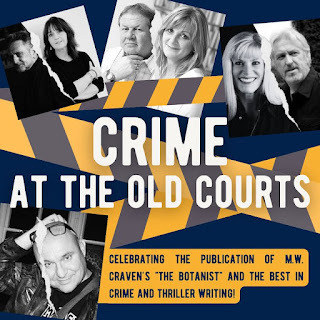 Celebrating the publication of
THE BOTANIST
, not to mention British crime and thriller writing in general, and hosted by Caz and Sam from the UK CRIME BOOK CLUB on Facebook, the programme will mainly comprise an afternoon of conversation with some of the bestselling authors in the crime genre, with a line-up that includes two 2022 CWA Dagger nominees, past CWA Dagger winners, Top 10 ‘The Best Crime & Thriller Authors of All Time’ (WH Smith Customer Poll), UK Crime Book Club book of the year winners, and a two-times British Fantasy Award winner.
Celebrating the publication of
THE BOTANIST
, not to mention British crime and thriller writing in general, and hosted by Caz and Sam from the UK CRIME BOOK CLUB on Facebook, the programme will mainly comprise an afternoon of conversation with some of the bestselling authors in the crime genre, with a line-up that includes two 2022 CWA Dagger nominees, past CWA Dagger winners, Top 10 ‘The Best Crime & Thriller Authors of All Time’ (WH Smith Customer Poll), UK Crime Book Club book of the year winners, and a two-times British Fantasy Award winner. As well as myself, the rollcall of writers who’ll be attending will include MW Craven, Caroline England, RC Ridgestock, Malcolm Hollingdrake and Patricia Dixon, all of us available to sign books (which can be bought there on the day).
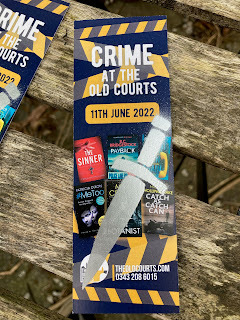 For tickets, follow this
LINK
. But there’s also a chance to win yourself a freebie.
For tickets, follow this
LINK
. But there’s also a chance to win yourself a freebie.Coming very soon via Wigan Libraries, pick up a book by any of the authors named above for a chance to find this ‘dagger in the library’ FREE entry.
We’re all very excited and anticipating a grand event in an atmospheric surrounding.
Of course, exactly the same thing was hoped for ChillerCon in Scarborough last weekend, and it fulfilled that expectation admirably.
Beside the seaside
ChillerCon was a slightly different beast from those other festivals I’ve so far mentioned in that it focussed primarily on horror fiction, rather than crime or thrillers (though all these disciplines, in my view, are horns on the same demonic goat). And this time in particular, certainly where I was concerned, there was a strong crime and thriller element. I was a guest on the Crime and Horror panel for example, which was great fun, especially as it was moderated by author, journalist and broadcaster, Barry Forshaw, a recognised expert on both genres. In addition to that, when ChillerCon was originally due to be held last March, it seemed like a good opportunity to launch my latest crime novel, NEVER SEEN AGAIN , as it was due for publication that same week.
You may wonder why a horror group would be interested in a crime novel, but through my helming of the TERROR TALES series, my own horror stories, my horror movie, THE DEVIL’S ROCK and my horror novel, STRONGHOLD , I like to think that I’ve got lots of friends and contacts over on that darkest side of all (plus, let’s be honest … it’s not like crime fiction and horror fiction don’t overlap regularly; it’s only the marketing people who try to sell them as completely different animals).
Anyway, the latter thing didn’t happen. You may remember that, back in March, the pandemic briefly threatened to rear its ugly head again, and so ChillerCon was delayed until last weekend, though thankfully, on this occasion it went ahead and was a genuinely splendid event.
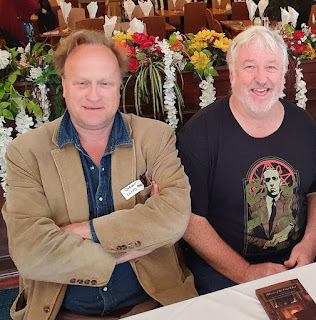 There were all kinds of illustrious horror people there, including Robert Lloyd Parry, whose one-man MR James shows really are something to behold (he’s pictured here alongside me). To add to the mix, there were lots of books launched, lots of readings, and a massive amount of genial bar-side chat.
There were all kinds of illustrious horror people there, including Robert Lloyd Parry, whose one-man MR James shows really are something to behold (he’s pictured here alongside me). To add to the mix, there were lots of books launched, lots of readings, and a massive amount of genial bar-side chat. It was one of the best events of its kind that I’ve attended, but it worked out especially well for me because, instead of launching NEVER SEEN AGAIN , which obviously couldn’t happen two months after it hit the shops, I opted to hold a charity event instead, signing and giving away as many copies of the book as I could for a £5 donation each, all proceeds to humanitarian aid for the Ukraine.
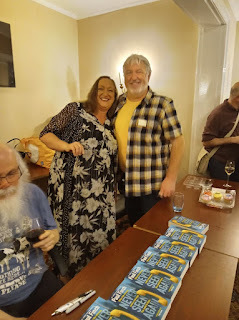 This went better than either I or my lovely wife, Cath (pictured here), who is so continually supportive, could have anticipated. Dozens of people attended, there was an electric atmosphere, and of the 40-odd books I had available, only four were left afterwards. We raised the total sum of £237.50, which even as we speak, is winging its way towards the Disasters Emergency Committee’s Ukraine Humanitarian Appeal.
This went better than either I or my lovely wife, Cath (pictured here), who is so continually supportive, could have anticipated. Dozens of people attended, there was an electric atmosphere, and of the 40-odd books I had available, only four were left afterwards. We raised the total sum of £237.50, which even as we speak, is winging its way towards the Disasters Emergency Committee’s Ukraine Humanitarian Appeal.I owe huge gratitude to everyone who came along, either to acquire a book or simply to offer moral support. It made an already really good weekend even better.
The future
Well, that’s it in terms of spring and early summer events, though some folk will be aware that once we get into high summer, mid-July to be specific, there is the Theakston’s Crime Writing Festival at Harrogate, one of the biggest on the circuit and an occasion that no aspiring crime or thriller author can ever afford to miss, and much later in 2022, November in fact, SFX XIII, which is primarily a sci-fi and fantasy convention. I’ll be at that one too, on that occasion probably wearing my DR WHO and TERROR TALES hats (not literally, of course), though I have to say that during the last one of these sci-fi weekenders I guested at, I signed many more of my crime novels than on lots of other occasions all rolled together, so you can never assume that everyone who attends these massive occasions will be hidebound by the subject-matter of the day.
THRILLERS, CHILLERS, SHOCKERS AND KILLERS …
An ongoing series of reviews of dark fiction (crime, thriller, horror and sci-fi) – both old and new – that I have recently read and enjoyed. I’ll endeavour to keep the SPOILERS to a minimum; there will certainly be no given-away denouements or exposed twists-in-the-tail, but by the definition of the word ‘review’, I’m going to be talking about these books in more than just thumbnail detail, extolling the aspects that I particularly enjoyed (I’ll outline the plot first, and follow it with my opinions) … so I guess if you’d rather not know anything at all about these pieces of work in advance of reading them yourself, then these particular posts will not be your thing.
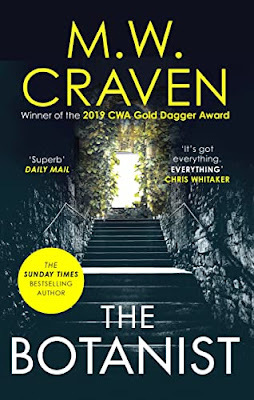 THE BOTANIST
by MW Craven (2022)
THE BOTANIST
by MW Craven (2022)
Outline
Kane Hunt, a misogynistic TV pundit who specialises in baiting feminists, is involved in a live television debate when he mysteriously collapses and dies. Shortly before this occured, Hunt revealed that he had received several death threats, including a letter containing a pressed flower and an odd but sinister poem.
Meanwhile, Detective Sergeant Washington Poe and civilian back-up, Tilly Bradshaw, key operatives in the National Crime Agency’s specialist Serial Crime Analysis Section, are on a stakeout to try and capture a Watford rapist known as Spring Heeled Jack for his ability to free-run across rooftops. Halfway through the case, Poe is distracted when he learns that Professor Estelle Doyle, the brilliant but adversarial forensics expert who has helped him during previous investigations, and one of his few close personal friends, has been arrested on suspicion of murdering her wealthy father in his palatial residence in Northumbria.
Poe immediately heads up there to get the facts, though the SIO responsible for Doyle’s arrest, Detective Chief Inspector Tai-young Lee, proves hostile, deeply resenting his questioning of her expertise. However, the problem for Doyle (and Poe) is that the evidence against her is overwhelming. Old man Doyle was shot dead in an armchair at his home, and his daughter, who has never denied being present, had gunfire residue on her hands. On top of that, it was snowing at the time, only one set of footprints were found leading to the house and these belonged to Doyle. It looks like an open-and-shut case, though Poe still refuses to believe that his friend is a murderer.
For her part, Doyle claims that she was invited to the house for lunch by her father, the twosome attempting to rebuild relations after years of estrangement, and found him in the armchair, already dead. Unfortunately, the fact that she and her father have long been at daggers-drawn provides motive in the eyes of her accusers.
While all this is going on, Tilly Bradshaw works out that the flower sent to Kane Hunt is part of a deliberate attempt to clue the police in about the rare poison used to kill him. Clearly, the murderer likes to play games and set his opponents riddles. None of this bodes well, and there is real concern when another flower, and another oblique poem, are sent to notoriously corrupt MP, Harrison Cummings.
Like Hunt, these ‘gifts’ are clearly intended to warn Cummings beforehand that he’s been marked for death, which seems bizarre as it obviously gives the cops an advantage. The MP is thus put under full-time protection and assumed from this point on to be safe.
The assumption proves incorrect.
Cummings is also killed by a lethal substance, the clue to the identity of which, only belatedly, become evident in the flower and the poem he was sent.
The NCAS now know they have a serial poisoner on their hands, whose ability to handle and administer extremely unusual and deadly materials, and who can get to his intended victims wherever they may be sheltering – ‘toxins for toxic people’, as it becomes apparent – are almost uncanny.
It would be a challenge for any police unit to tackle such a case, but Poe must continually divide his time between this enquiry and his attempts to work out who has framed Estelle Doyle, perhaps dedicating more time to the latter than he should, because he finds it utterly baffling and increasingly feels that Doyle is heading for a lifetime in prison.
In terms of the poisoner, the team is briefly diverted by a potential suspect who actually works for the Parliamentary Protection Corps, though this proves to be a red herring because then the real killer – ‘the Botanist’, as he is now known – makes actual contact with them.
He insists that he only kills narcissists whose presence in society is damaging it, and demands that a once-famous but now disgraced and burnt-out journalist, Henning Stahl, be brought out of retirement to tell his story. He also promises that he will keep on killing.
Stahl, a long term alcoholic, is a sad mess and has no clue why the Botanist has chosen him to be the conduit, but he is prepared to attempt to get himself together as he can sense that this may be his way back to the limelight.
Meanwhile, a prominent internet influencer, Karen Royal-Cross, appears online, taking a break from her usual tirades against illegal immigrants, and those ‘libtards’ who support them, to laugh about the fact that she’s just received a pressed flower through the post and a slightly crazy poem.
Clearly, the Botanist intends to continue with his work, publicly singling out those he considers unworthy of life, and then successfully eliminating them wherever they are hiding, by means that are almost undetectable …
Review
There is simply no way to dislike the Washington Poe series.
MW (Mike) Craven has done fantastically well with these books for all sorts of very good reasons. I’ll try to assess these one by one as we talk about The Botanist , because despite the high bar that Craven set for himself in previous volumes, The Puppet Master , Black Summer , The Curator and Dead Ground , this one, the fifth in the series to date, is the best, and exemplifies everything the author is doing right with these books.
First of all, we have the characters.
Washington Poe himself (the name alone is instantly memorable) is everyone’s idea of what a good copper should be. He has a soul and a conscience, he strives always to do the right thing, but at the same time he is pleasingly unforgiving when it comes to violent criminals. An ex-soldier, Poe is in many ways ‘old school’, even though he works for the super politically correct National Crime Agency. He knows there is all kinds of tech at his disposal, but he prefers to work his cases with boot-leather. He can be blunt, gruff and to the point, is good with his fists (and sometimes quick) but he’s not a violent cop. He’s affable with the general public and a warm presence among friends and neighbours (it’s also the case that his dog, Edgar, adores him, always a giveaway that this is one of the good guys). He lives frugally in a reclaimed croft high on Shap Fell, making him one of the lowest-maintenance heroes I’ve thus far encountered in fiction.
However, his most attractive traits are his failings. Poe has long been unlucky in love (up until now, maybe), in personal terms leads a lonely existence, and deep down is plagued by self-doubt. He’s not always au fait with the most modern police techniques and is often frustrated by them, but he’s not a maverick, he’s a team-player, who trusts and relies on his colleagues. Like other real people, he also makes mistakes, though more often than not, when this does happen, he still tends to work his way through to a result.
But Washington Poe is only one half of this ultra-effective crime-fighting team. The other is Tilly Bradshaw, who is the polar opposite of her rugged male colleague. Her official role is as intelligence analyst and online researcher, and yet she’s inordinately naïve, verging on being autistic. She possesses zero people skills, a sense of humour that no one else understands, and is often frightened and bewildered by the dreadful extremes of evil that she encounters in her job. But all this is the key to her relationship with Poe, who, over the course of several tense enquiries, has morphed into the parent/sibling and, most important of all, friend, she never previously had. But while Poe is mostly instinct, Bradshaw is primarily brain. She has an incredible facility to retain information across a range of disciplines, while her grasp of logic is astonishing, and her ability to calculate quickly and accurately, mesmerising; she is undaunted by the seemingly most complex problems.
This is what makes the two-handed team so formidable, but also such a delight. These are buddy-buddy cop stories of a very different ilk, not so much relying on wisecracks and banter, but on MW Craven’s ability to find genuine but often gentle humour not just in Bradshaw’s innocence, but in the often awkward and even embarrassing questions that it poses for Poe.
The secondary characters in The Botanist are equally interesting. DI Stephanie Flynn is Poe’s line-manager, an archetypal no-nonsense gaffer who will back her team and bollock them in equal measure. She’s by-the-book but not rigidly so, especially where Poe is concerned, because she’s been around long enough to know that law enforcement can’t always be like that. Then we have Estelle Doyle, the cool, clipped and beautiful forensics specialist, whom the team rely on continually, and who, once, she’s been accused of murder, Poe seems to grow an extra arm and leg in his efforts to rescue. Clearly, he’s long carried a candle for her, even though superficially they are chalk and cheese, and maybe on occasion she’s hinted at returning the chemistry … though that’s all I’m going to say about that (yes, there are some crucial developments in this relationship).
This brings us to the book’s next big asset … its villain.
It’s always difficult to talk about villains when reviewing a thriller, for the simple reason that you don’t want to give anything away. I thus can’t reveal too much here, but I will say that while Mike Craven has always employed majestically villainous villains, the Washington Poe novels are also reminiscent of the real world. You won’t find the Joker in these stories, or Auric Goldfinger. Poe deals with criminals whose prototypes genuinely exist (mostly serving life sentences in supermax prisons around the world). Realism is everything. Though that doesn’t stop them plumbing the depths of wickedness, and in The Botanist , even given those strictures, he takes us as close to super villainy as it’s possible to imagine.
It’s all the more effective, because when the killer here is finally unmasked, and because Craven has yet again indulged in his meticulous research, we find ourselves confronted by an individual whose insanity is as compelling as it is terrifying, and yet who is entirely believable. With the assistance of real life scientist, Brian Price, who is credited at the end of the book, Craven has also given us a poisoner of such ingenuity that no one appears to be safe from him, anywhere, at anytime – at one point, Poe declares that it’s almost like black magic – and yet it’s not a fantasy, it’s all scientifically possible. At the same time, the titular Botanist ticks all the correct psychological boxes for a convincing member of the criminally insane fraternity. We genuinely know that such a malformed personality could exist, because we’ve all seen them on True Crime programmes.
Authenticity is always – but always – the key for Mike Craven.
Washington Poe might almost be a figure from the Wild West, but this is not that place. In police terms, this is a world of hard rules and high technology. It’s a time when crimes are no longer solved simply by kicking doors down, but by attempting to read the unhinged mind, where medicine and forensics are artfully used in the pursuit of justice, and where there are no grey areas when it comes to procedure; procedure can be an ass, but you’ve got to be clever to get around it, not just bull-headed.
Craven sprinkles The Botanist with all these contemporary details, and yet none of it gets in the way. There’s an unwritten rule in crime-writing: don’t let the facts spoil the story. Ultimately, you’re telling a yarn and you want to excite and intrigue your readers; informing them about modern policing culture and technique is a secondary consideration. But if you can hit that button too, and not interrupt the narrative, in fact maybe even bolster it (because legal minutiae and the like can often create fortuitous and unforeseen twists in the narrative, and certainly does here), you’re doing an even better job.
And this is the whole story with The Botanist . You get immersed in detail, and yet it remains nail-bitingly tense. This maniac can genuinely strike anyone anywhere … and that becomes an overwhelming factor as you read. He welcomes pursuit by the police because he likes to show off how cunning he is, and this device alone works tremendously, hitting us with ticking clocks aplenty and one compelling scenario following another, though each time the villain is two steps ahead. At the same time that all this is going on, you’re completely hooked by the ‘locked room mystery’ that has seen Estelle Doyle charged with murder. You know she hasn’t done it; she’s a recurring character and a paid-up good guy, but the evidence seems insurmountable. Eventually, you have no choice but to contemplate the unthinkable …
The Botanist is second-to-none. It’s been a great series so far, but this is the best volume to date. A fast, enthralling and superbly executed read, which deserves to be read by every crime fan out there.
When a book is the fifth in the series, it hardly seems sensible to talk about who you’d love to see playing the leads should it ever get a film or TV adaptation. Surely that should be reserved for the first one? Well, The Puppet Show was the first in the Washington Poe series, and I did exactly that when I reviewed it several years ago. Therefore, I’ve got no hesitation in nominating a cast for this one too, utilising the same actors in the same roles that I did the first time round, and adding yet more talent for this latest outing. (It’s only a game of course, but it’s fun):
DS Washington Poe – Nick Blood
Tilly Bradshaw – Ella Purnell
DI Stephanie Flynn – Joanne Froggatt
Professor Estelle Doyle – Claire Foy
DCI Tai-young Lee – Han Hyo-joo
Henning Stahl – Paul Kaye
The Botanist – Arthur Darvill
Douglas Salt – Jason Isaacs
Published on May 31, 2022 14:14



